If it’s your first time at Kruger National Park, you will undoubtedly be a little overwhelmed with all the choices and decisions you have to make. Luckily, it’s a lot simpler than you think once you know what to expect. This guide goes through everything that you need to know when it comes to planning your first safari adventure in South Africa known to be one of the best places in the world to see the “Big Five” – Lion, Elephant, Leopard, Buffalo and Rhino.
Read more about South Africa
- How to Plan a Safari in South Africa
- 13 of the must-see things in Africa
- Shark cage diving in Gaansbai near Cape Town
- What to pack for a beach and bush vacation to South Africa and Seychelles
- What it’s really like to safari in South Africa
Where to book hotels?
- For our trip, we primarily used Booking.com because with their Genius tier, we could often save 10-15% off stays.
- South Africa also has the Protea brand under Marriott so for those that are Bonvoy members, it’s a great way to spend your points because they are mostly low category.
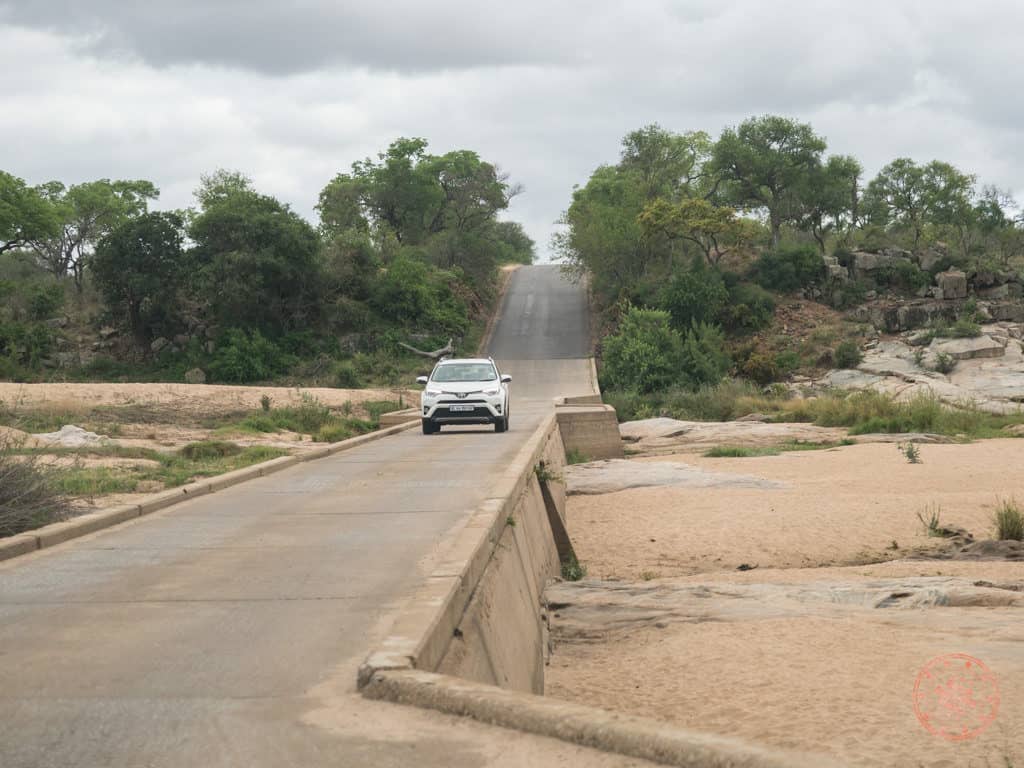
In This Article
About Kruger National Park
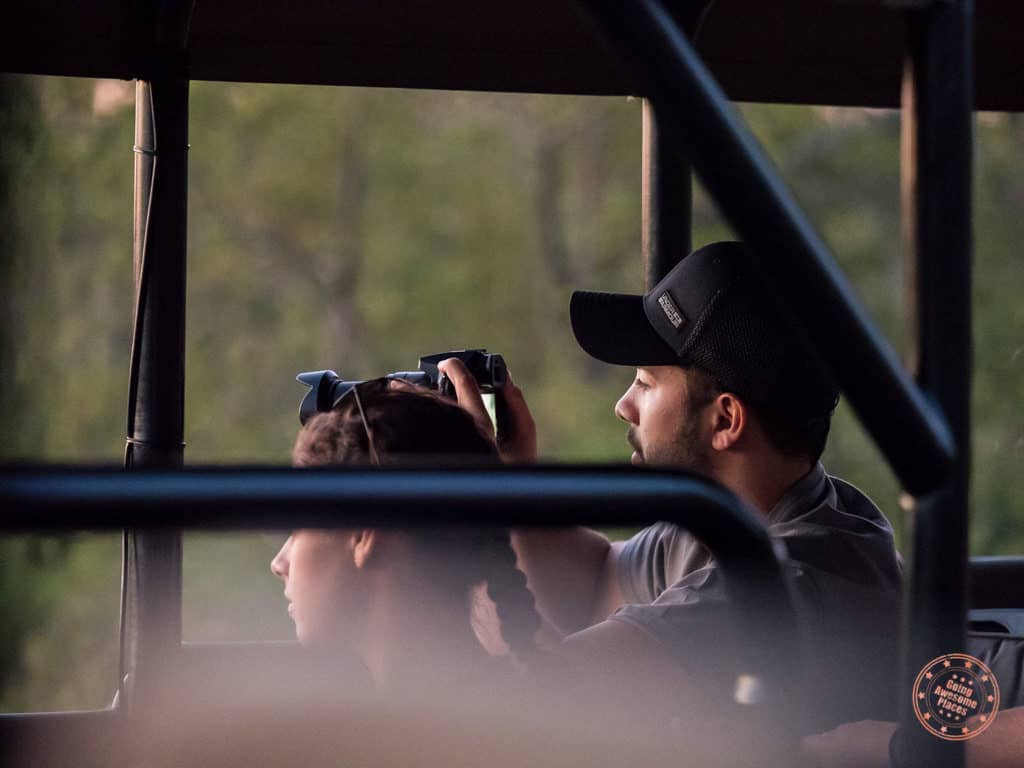
Kruger National Park is easily one of the world’s greatest game parks. It’s known for its professional management of wildlife, nature conservation, and safeguarding of African cultural heritage. It’s developed significantly since it was officially opened as a park in 1927 but the history goes far before that.
There’s evidence that prehistoric man roamed the region and that leading into the Stone Age and Iron Age where there are actually a number of archeological sites and cultural artifacts discovered on that same land.
In 1898, The Sabie Game Reserve was established with the thanks of Paul Kruger who wanted a way to preserve the wildlife in the region which was dwindling in population because of excessive hunting. In 1902, the first warden was appointed and his name was James Stevenson-Hamilton with nickname “Skukuza” which means “he who sweeps clean” because of the work he did to eliminate poaching in the area. Finally, in 1926, the Parliament passed the National Parks Act and various game reserves were merged to create Kruger National Park before opening in 1927 to the public.
Deciding where to stay in Kruger
This can be an incredibly complicated answer but if we’re taking this from the perspective of 1) This is your first time in Kruger and 2) You have limited amounts of time, your choices are going to start narrowing down to where it becomes much more manageable.
Kruger is massive. Take a look at this map and you quickly realize that there’s no way you can even see 10% of the park in one trip. It’s so huge that it borders Zimbabwe in the north and and is right along the western border of Mozambique.
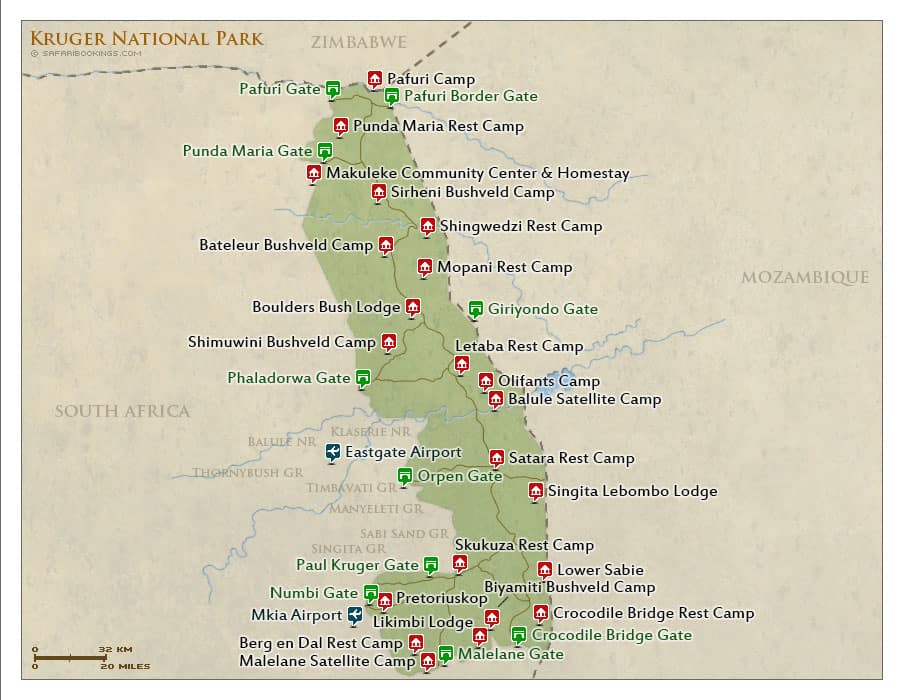
In a nutshell, Kruger is comprised of several main gates. You’ll see those marked in green and these are the entrances where you can . Then you have the rest camps which have a varying mix of facilities such as restaurants, cafes, gas stations, and accommodations. These camps are gated and will naturally be your base of operations.
The question I asked was “where do first timer’s go?” You’ll notice the large cluster of gates and camps in the south and that’s not an accident. It’s the easiest to get to and more popular because this area is known to have a higher concentration of wildlife because the southern park has higher rainfall. I’m not going to guarantee it but you will most likely be exploring Kruger from Orpen Gate and below.
Rest Camps
A big part of it was logistics because I knew that I wanted to do a private reserve and self-drive in Kruger. For me it was about how could I combine my loop without going really out of the way and also what were the availabilities of the camps in Kruger and Elephant Plains.
The truth is, you really can’t go wrong no matter where you go. If you’re going to be focusing on the south, as you most likely will, the wildlife that you’re able to see will be very similar. Ultimately, it’s really luck that you need on your side and good eyes.
It’s hard to understand which rest camp to pick without actually being there but if I can simplify things for you, here are questions you want to ask yourself and points to consider:
- Where you stay in Kruger will determine the roads that you explore and you won’t go as far as you think you will so in a way you want to pick carefully.
- Each rest camp differs quite drastically with the number of services they offer (i.e. restaurants, cafes, gas station), types of accommodations, size, and in general how modern they’re developed
- Focusing on accommodation, the bungalows were very different in style so if you have specific needs such as an indoor kitchen vs outdoor kitchen, availability of BBQ, and overall size, you’ll need to do your research
- Camps offer different activities so this could sway your decision
- Which gate you plan on entering in from will likely determine where you start or perhaps it’s the other way around. For instance, Berg-en-Dal and Crocodile Bridge rest camps are the main ones to south but if you’re planning to enter through the west you’re likely looking at Pretoriuskop or Skukuza.
My recommendations for where to stay in Kruger
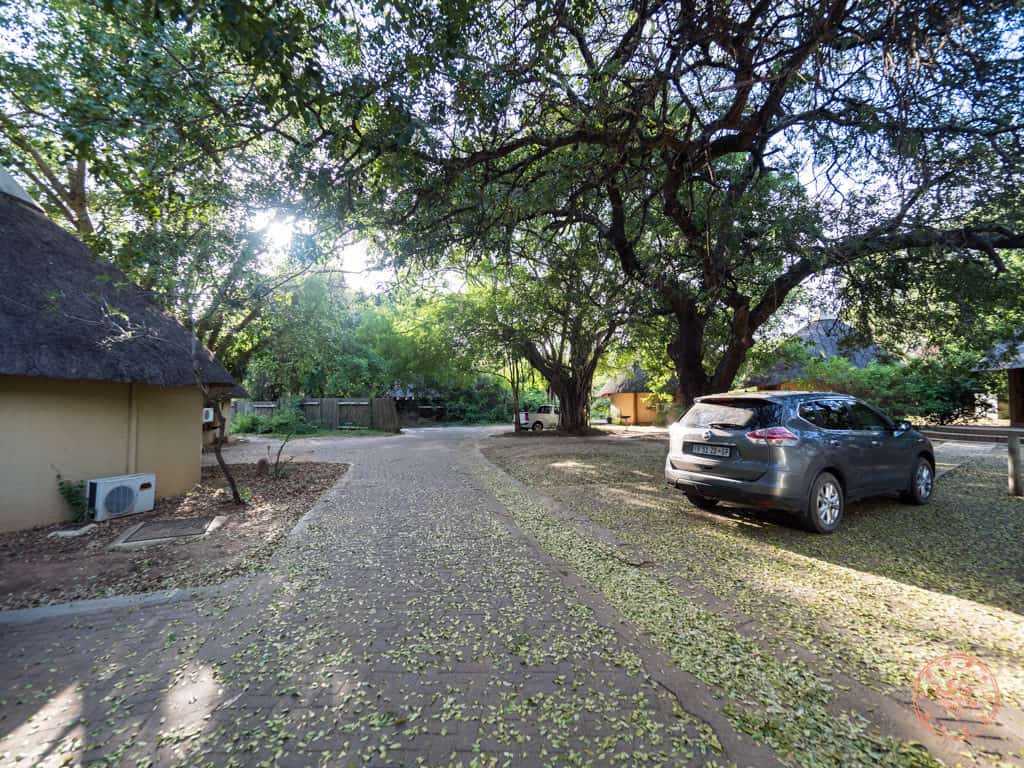
It might be easiest if I go through my decision making process and hopefully yours is relatable.
Trip parameters
- Only have 3 nights to work with so off the top I knew that at a maximum I really only wanted to try two rest camps.
- We would be finishing with the Panorama Route before heading into Kruger so this put is closer to Paul Kruger gate. It did not make sense for us to start in the most southern part of the park.
- We weren’t exactly looking for an extremely rugged bushveld experience but if one was available, I would consider it
- Bungalows that had their own private bathrooms were key given that this was our honeymoon and there was no way we could do camping.
Picking our rest camp
- From everything I read, Skukuza is the biggest rest camp with the most amenities. Now we didn’t care for the golf course that’s there but we knew there was the biggest park shop for supplies and several options for meals whether it be quick lunches or proper sit-down meals. It also didn’t hurt they have a great view of Sabie River that runs in front of it.
- Skukuza just made sense as a place to start because it seemed like a really comfortable place to get acclimated to how Kruger works and the game sightings in the area looked quite appealing as well
- Not wanting to move right away, we decided to start with 2 nights here
- With 1 night left, I started looking at bushveld camps with their cottages and safari tents but availability was looking slim
- Satara was in the mix but it was quite the long drive north when moving camps and it would also take a long time to exit the park on our last day
- Ultimately Lower Sabie just seemed to keep things simpler and I liked the set up of the camp with really good views of Sabie River
What if we started with Kruger straight from Johannesburg?
This is a valid point because our driving routes would’ve been different. If this was the case, I probably would’ve picked Berg-en Dal or Crocodile Bridge camps to start since it would’ve made more sense to enter the park from the south.
Using the SAN Parks booking system
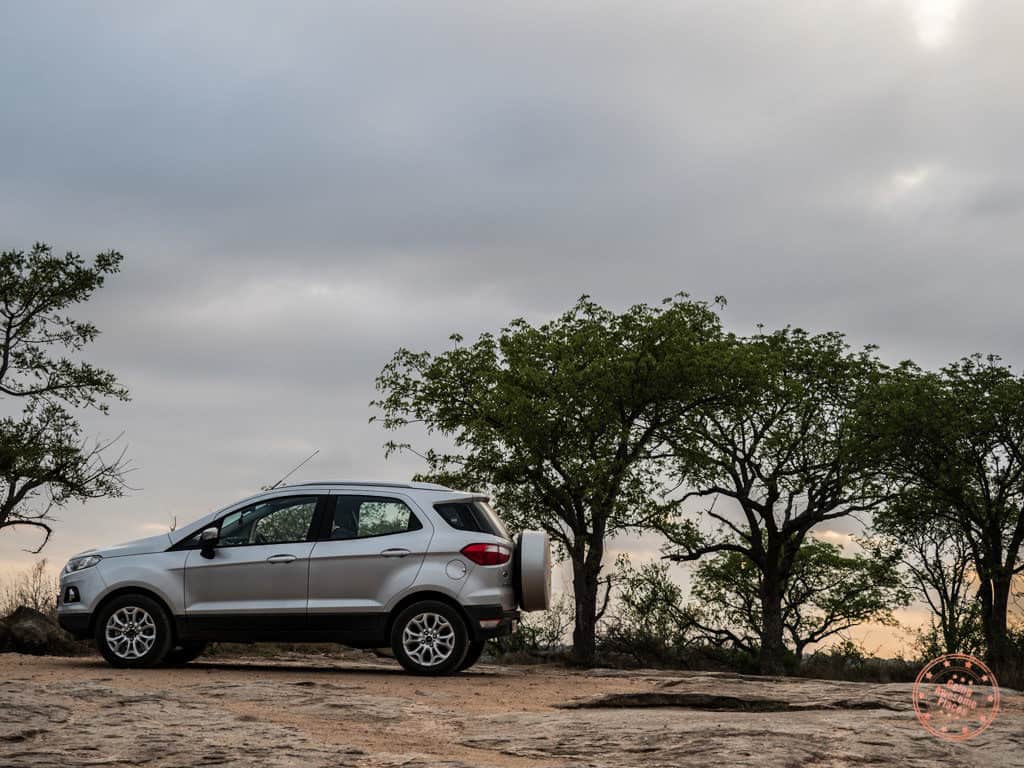
The South African National Parks (SAN Parks for short) surprised me by having a pretty in depth booking system online. The good news for everyone is that you can book your entire Kruger National Park experience online.
South African National Parks booking system
Thankfully the system is relatively easy to navigate and makes sure you don’t do anything stupid. It’s smart enough to know that you can’t book an activity unless you already have an accommodation booking in the camp and the data is real time. It tells you exactly how many spots are left.
There’s a but of course. As nice as it was to have this online system, it’s not the most user friendly especially if you’ve never been to Kruger. Here’s what you can expect.
Too many options
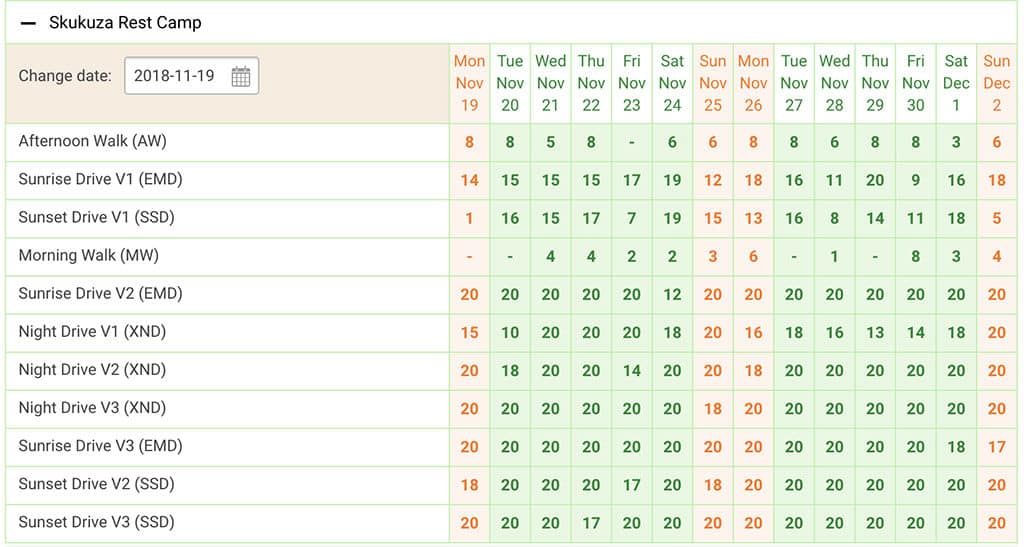
While I now understand what’s going here, if you’re looking at this for the first time, you’re probably wondering what the difference is between Sunrise Drive V1, V2, and V3 and likewise for the Night Drive and Sunset Drive. The codes just add to the confusion.
For the activities, these are just all the same thing but they’ve got 3 safari trucks available because they know there are a lot of people wanting to do these trips.
What are these accommodations actually like?
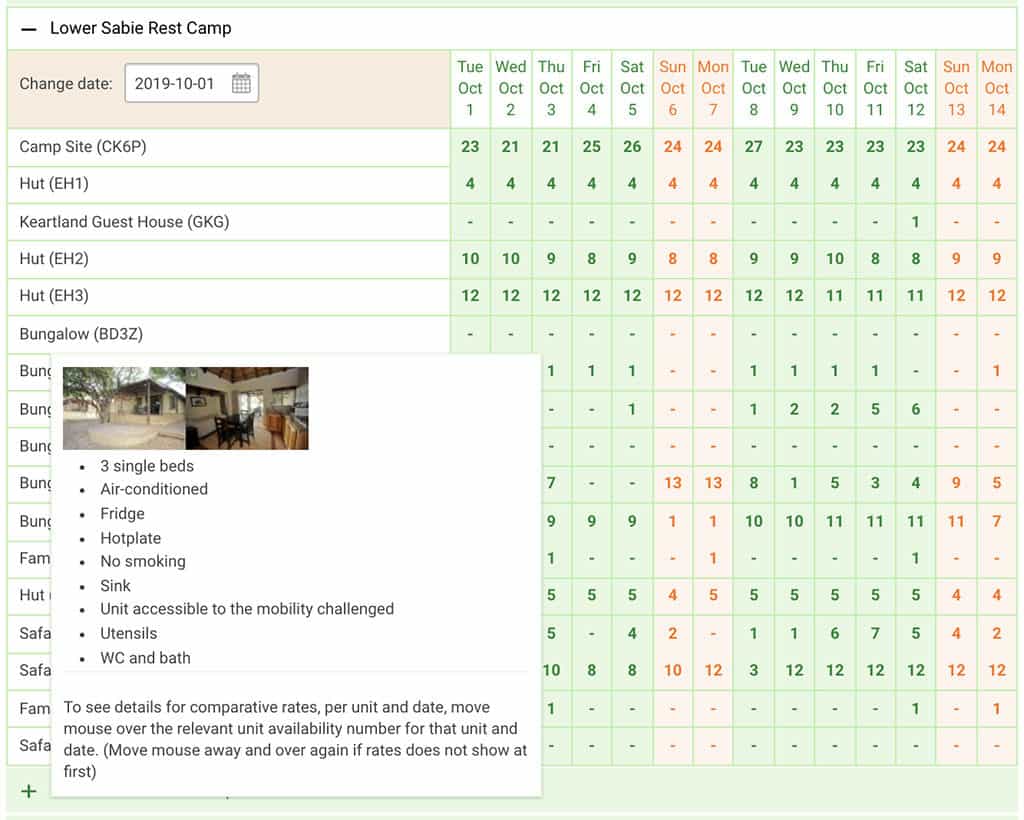
This is the most frustrating part. The booking system does a terrible job at showing you what the accommodations look like. You need to do your research outside of the website to figure out what each of the bungalows are like. When you hover over each one, all you get is a tiny thumbnail and basic description that it really doesn’t help at all.
Like the activities, you’re also overloaded with too many choices as they list out every single combination and permutation and their individual codes.
I got so fed up that I just randomly picked one.
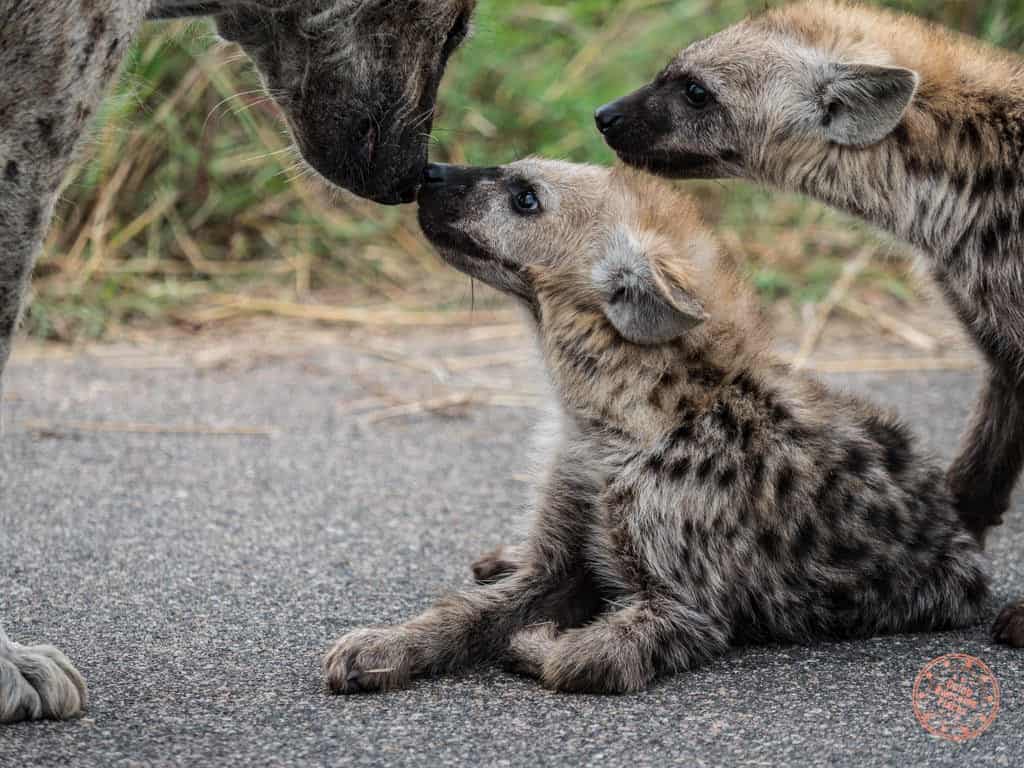
Other things you need to know
- A 1% community fund is added to all transactions
- Daily conservation fee is quite substantial so expect that to be added to your total. At the time of writing, this was R328 for adults and R164 per day. You have the option to pay this online with your booking or in-person. It’s probably easier to just take care of it all in one go online.
- Double check before you book because the cancellation fees are quite harsh
- Full payment is required via credit card
- Check-out time is 10AM and check-in time is 2PM
- Email confirmations will be sent out after every change
- An email package containing a set of PDFs will be sent as well which includes an indemnity form. You can have it filled out ahead of time or just fill one out when you sign-in
- No liquor is allowed to be brought into the park
Travel Tips – Unless you’re really not sure what your schedule is going to be like, I’d try to book as much as you can ahead of time because things sell out quickly. You also don’t want to have to be worrying about this stuff and going to the reservation office while you’re there.
How self-drive safari works
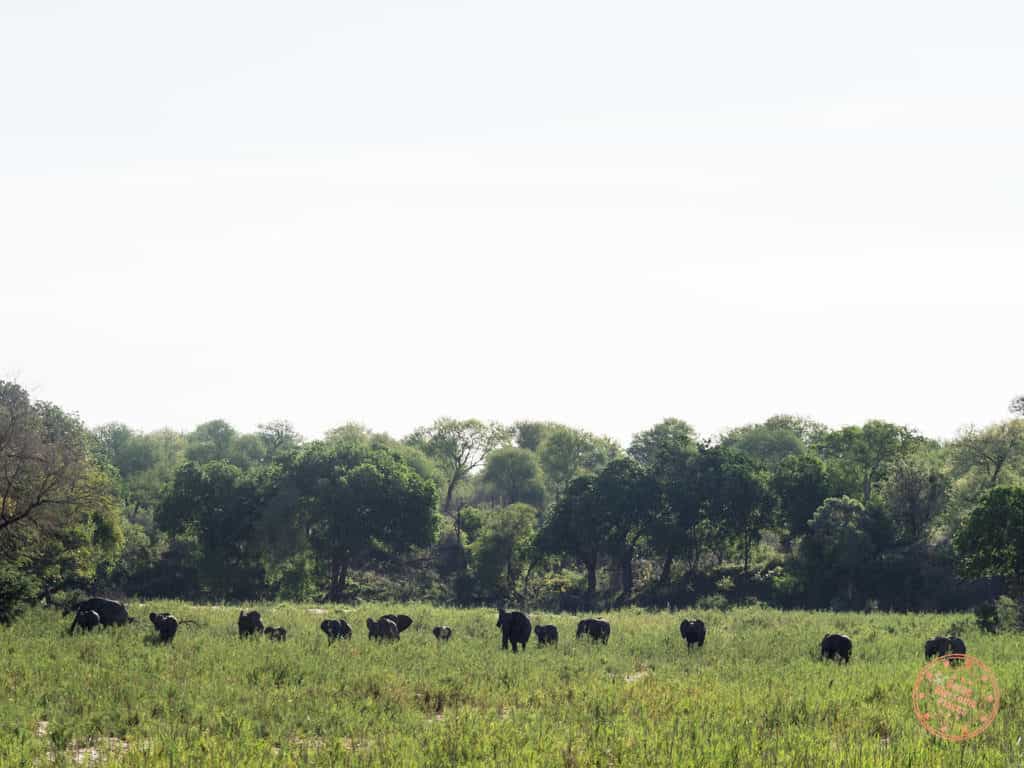
Remember those choose-your-own-adventure books where you were making decisions about where your character should go or what they should do next? The self-drive safari in Kruger National Park is kind of like that. There are a bunch of different roads to choose from and every day you pick where you want to go. Some roads will have nothing to see and others will yield some incredible sightings. You just never know!
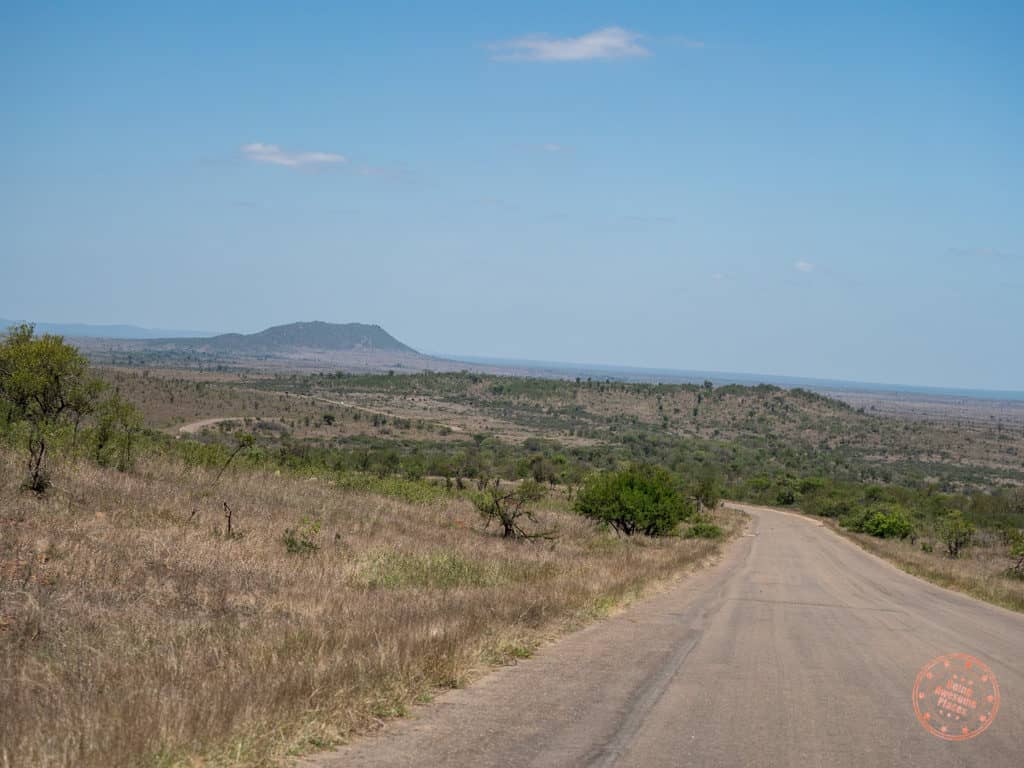
I recommend picking up a Kruger National Park guide book that they sell in all of the gift shops. They come with detailed maps that mark all the tarred (paved) and dirt roads.
For more details about how we ended up planning our safari through Kruger, make sure to head over to the guide for the Best Way to Safari in South Africa in Kruger National Park and Private Game Reserve
How to have better chances to spot wildlife
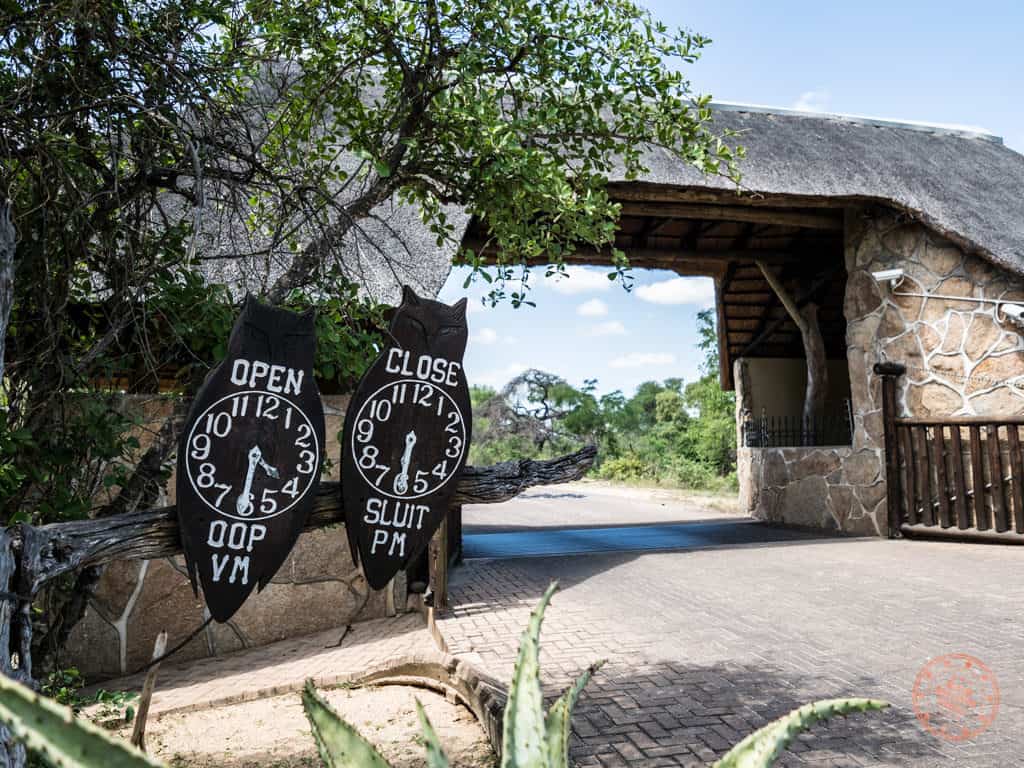
The key to success here is to wake up early and be ready to drive out of the gate right when it opens. This is when a lot of animals are still quite active as the temperatures are also much cooler. November – January, the gate opens as early as 4:30AM so plan to be out until 10 to 11AM.
While the sun is on full blast in the afternoon, the temperatures rise so high that all the animals duck for shade and so your chances of seeing anything are pretty small. We did it on one occasion and we mostly just saw elephants hiding under trees. The afternoon is a great time to grab lunch and rest at camp.
Plan to head back out by 3-4PM again as the sun starts to lower. Animals start coming back out again and so maximize what time you have left until your gate closes. This could be as late as 6:30PM. Once the gates close, you’re not able to head back out.
Travel Tips – Waterholes can sometimes be a goldmine for sightings because animals small and large head there to hydrate or hunt their prey. It’s always worth swinging around there. Some may be empty but some may surprise you.
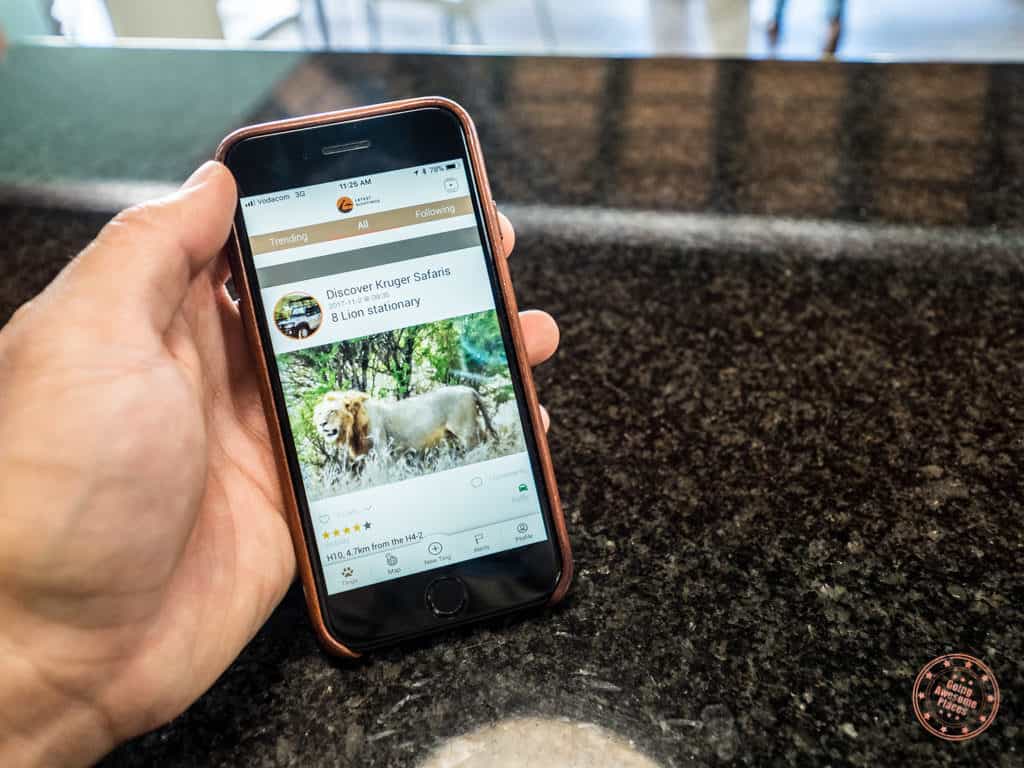
Travel Tips – Download the Latest Sightings app (iOS/Android) which is crowdsourced by people that are in the park. The app can be a bit clunky but it’s neat to see it all come in live. Of course, every time I opened the app and saw big sightings, we were never close to the area so it’s hit or miss.
Activities available at each rest camp

Each rest camp offers their own set of activities for guests and you’ll want to take advantage of them while you’re there. Keep in mind though that you can only book these activities if you’re actually staying in the rest camp that’s offering them.
Bush Walks
The one activity I do recommend that you do is the morning or afternoon walk. It’s one of the few ways you can actually walk in the park. It’s fully guided with two armed rangers and kept in small groups of 8 or less. Sure, you probably won’t see any big animals (you really don’t want to encounter any) but it was an incredibly way to see the landscape up close, immerse yourself with the African bush, and learn quite a bit from the commentary from the rangers.
Game Drives
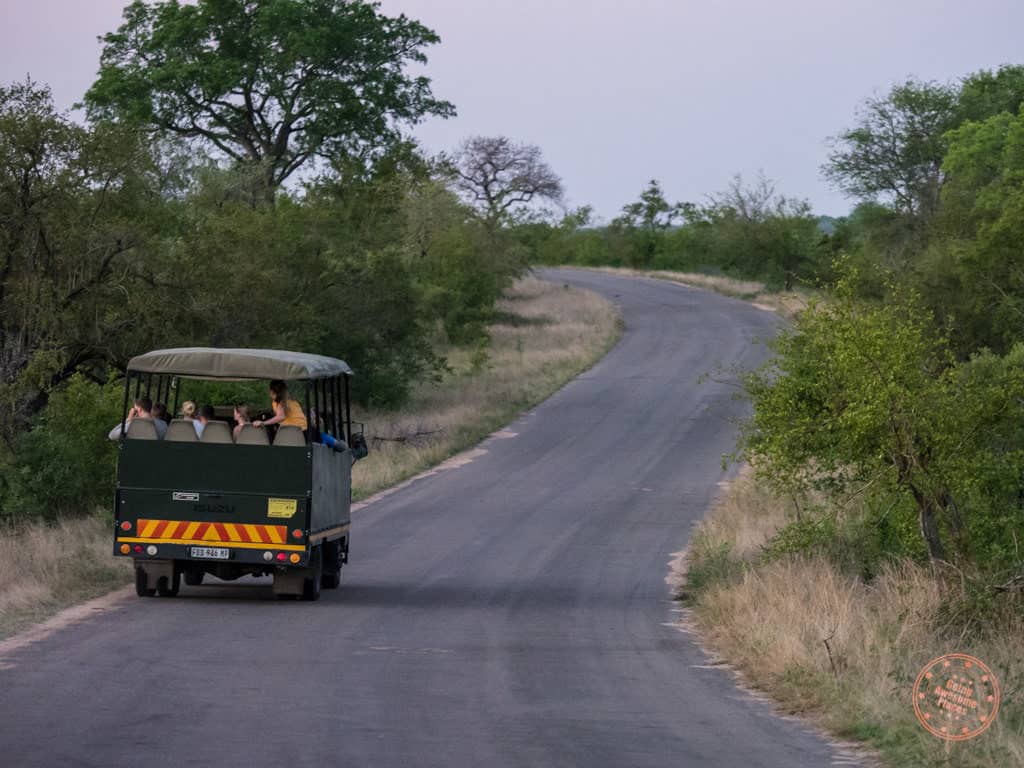
I was a little disappointed with the sunset drive and night drive that we did however I think a lot of that has to do with us having come from a private reserve. If you’re only doing Kruger National Park, I still think the drives are a great way to see animals because they can communicate with other park drivers and lock in on sightings. The night drive is hit or miss but in our case we got to see two lions hanging out on the road so that was pretty amazing.
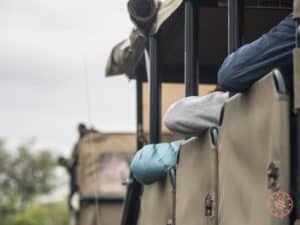
Why were we disappointed? It starts with the boarding of the buses. They’re of coursed fully booked and you quickly learn that it’s a free for all and “fend for yourself” kind of system. When the ranger comes out, everyone rushes in and tries to get checked-in as soon as you can. Everyone knows that having a good seat matters on these drives. It was way too stressful.
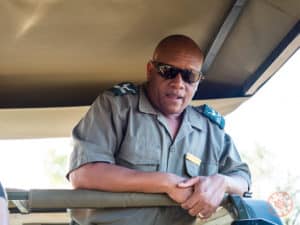
The commentary wasn’t particularly riveting and if you sat near the back, you could barely hear anything. It also didn’t feel like the spotter was working particularly hard to spot wildlife but perhaps we just weren’t as lucky.
You also have to remember that this is a big truck and so what that means is that somebody’s going to have either a head obstructing your view or a tree. The driver tries their best to change the angles of the truck and move backwards of forwards to give everyone an equal chance but I felt like it was always biased towards the front.
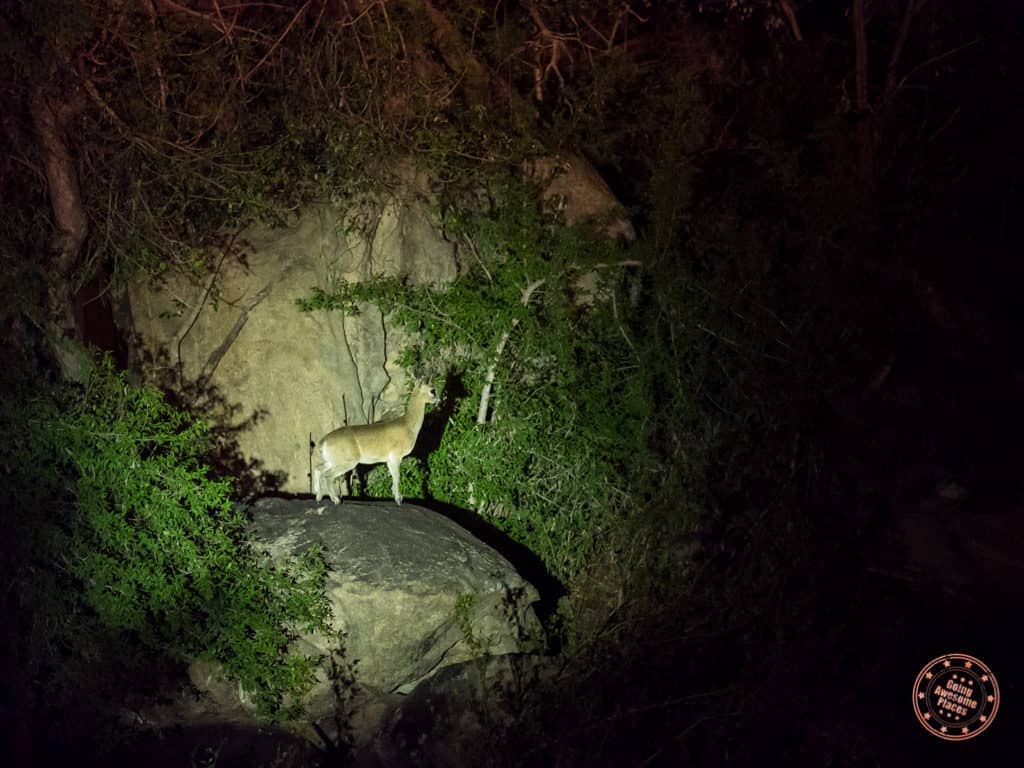
Lastly, the night drives depend on passengers to shine the flood light. This puts too much reliance on the passenger to know what to do. On the one drive we were on, the person manning the light was either passing out or didn’t care to shine it at the right angle the driver wanted. It was frustrating to say the least.
It should also be noted that there are some interesting multi-day activities as well that include Olifants River Back-pack Trail, Wolhuter Wilderness Trail, Bushman Wilderness Trail, and more.
Travel Tips – The best seats are the ones near the entrance steps into the truck. I like this spot mainly because you don’t have a row of heads in front of you to potentially obstruct your view and if you need to move out to the entrance steps, you can get there quickly. The worst seats is the back row where you’re sandwiched in and very hard to get a good view.
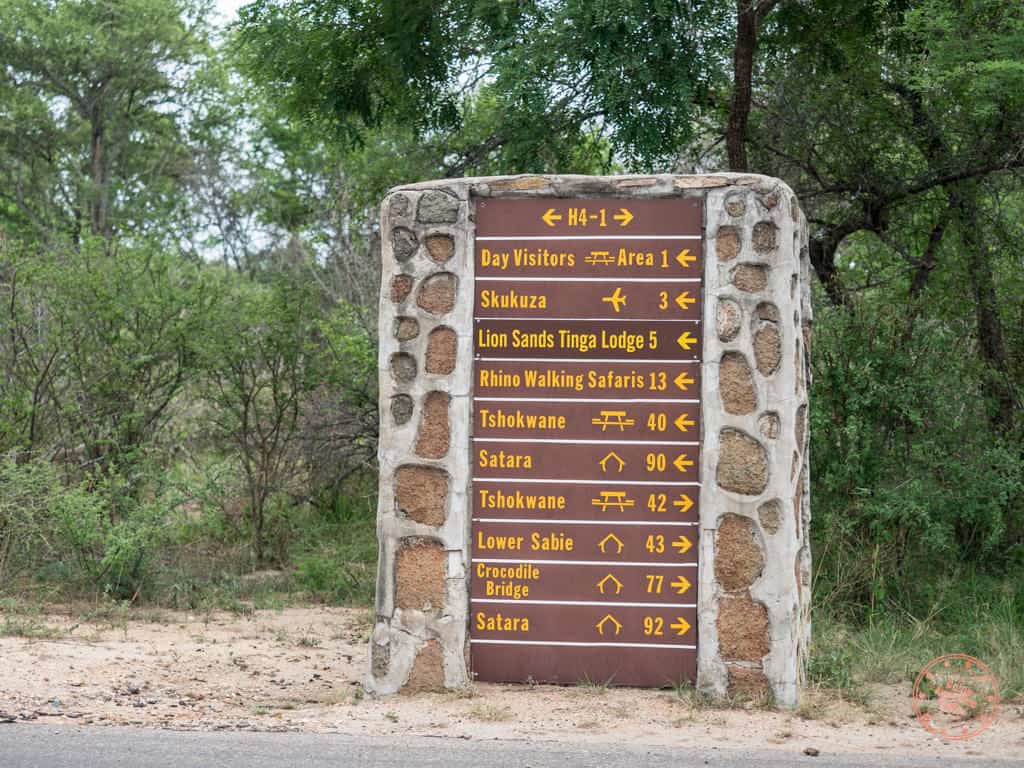
Review of Skukuza
You can say that the Skukuza rest camp is the capital of Kruger National Park. It’s the largest camp and has the most complete collection of facilities. As a result I found that this was the most beginner-friendly of all the camps. While the grounds are large, the layout is easy to navigate and everything you need, they have.
Another reason why it’s so popular is because of all the wildlife that can be spotted in the area. It’s in the heart of Big 5 territory so your chances of seeing something exciting are quite high once you exit the gates.
Key Features
- Wide variety of accommodation types
- 9 hope golf course
- Amazing riverside walks and wilderness hikes
- High chances of spotting the Big 5 here
Grounds
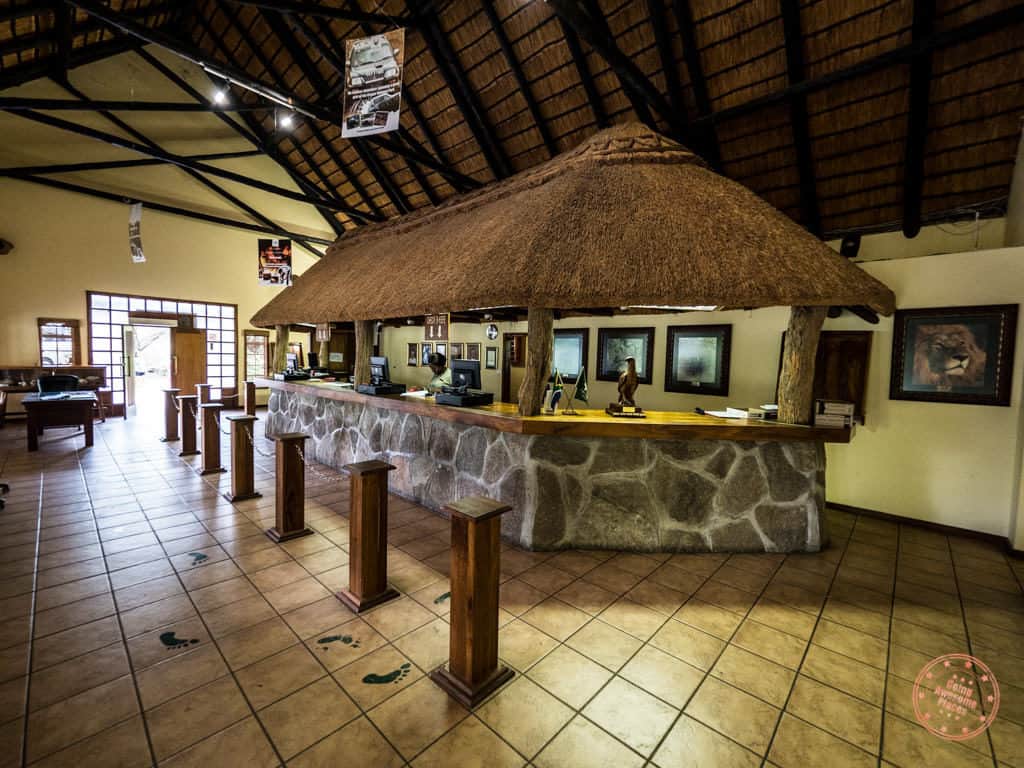
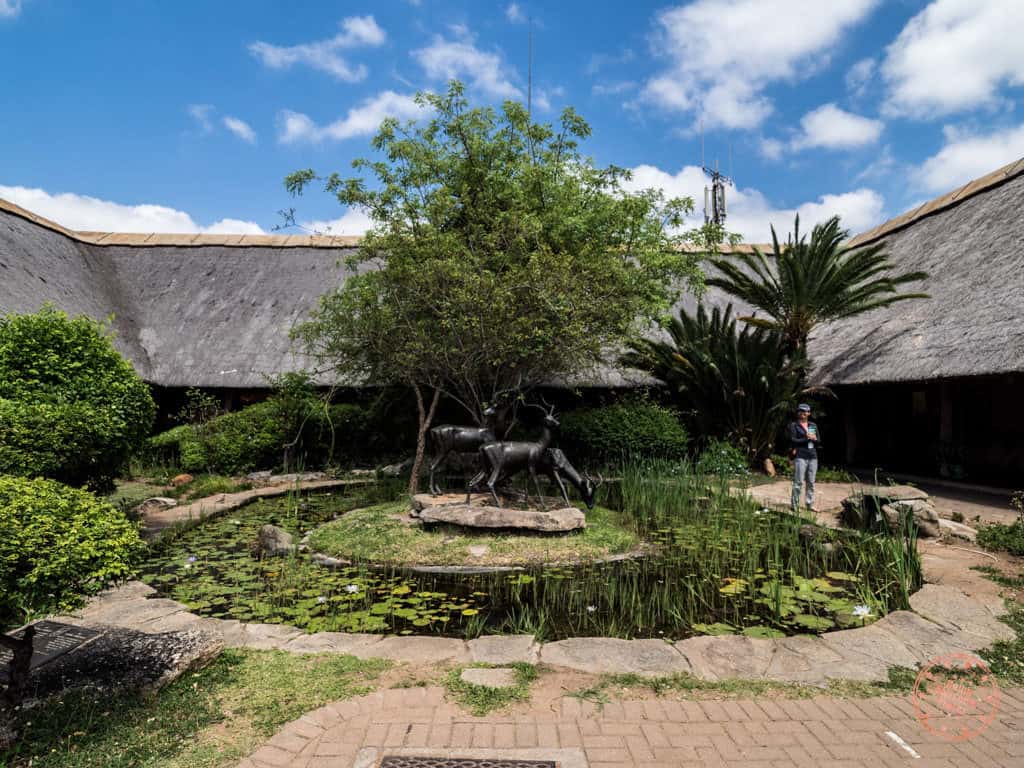
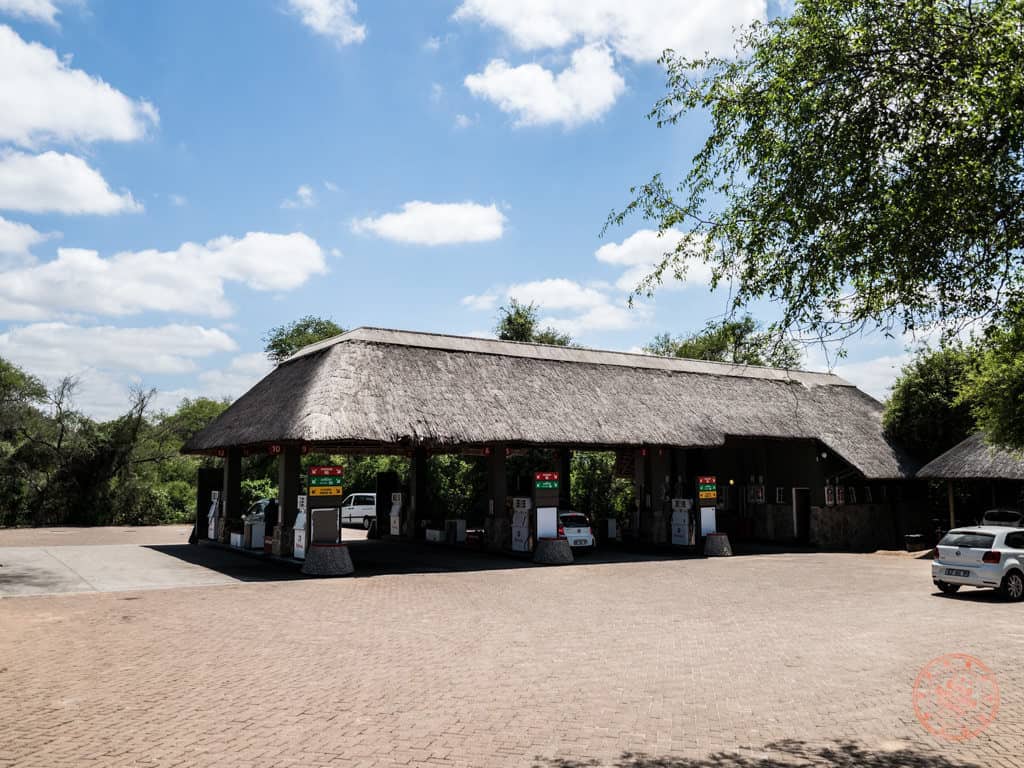
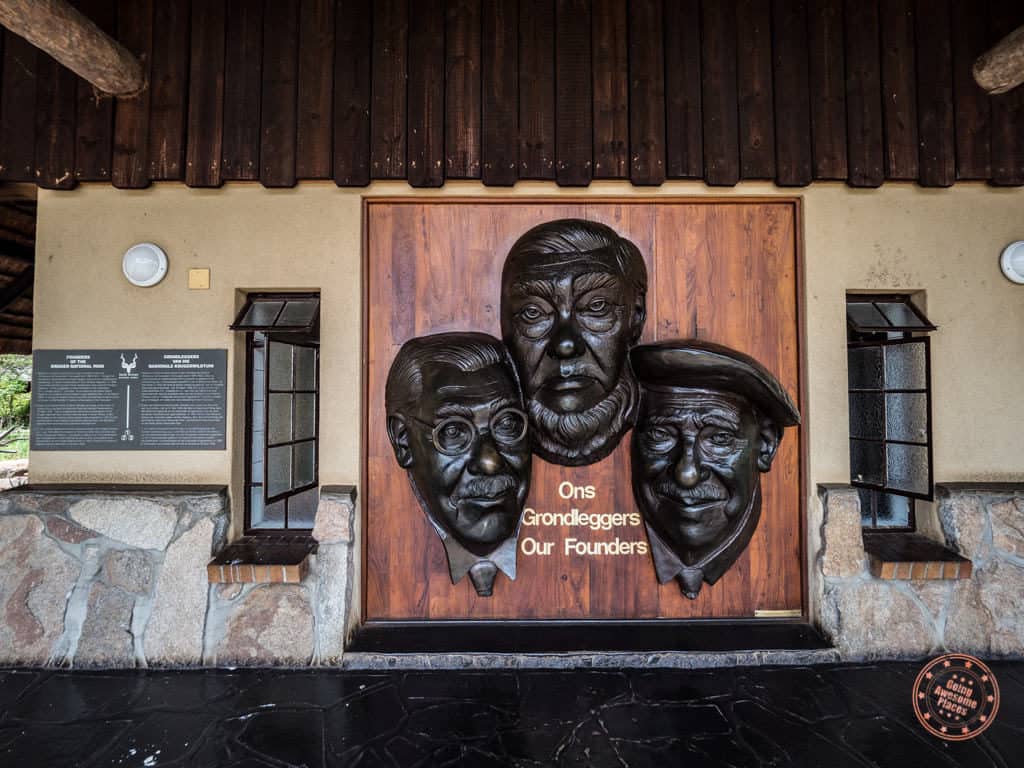
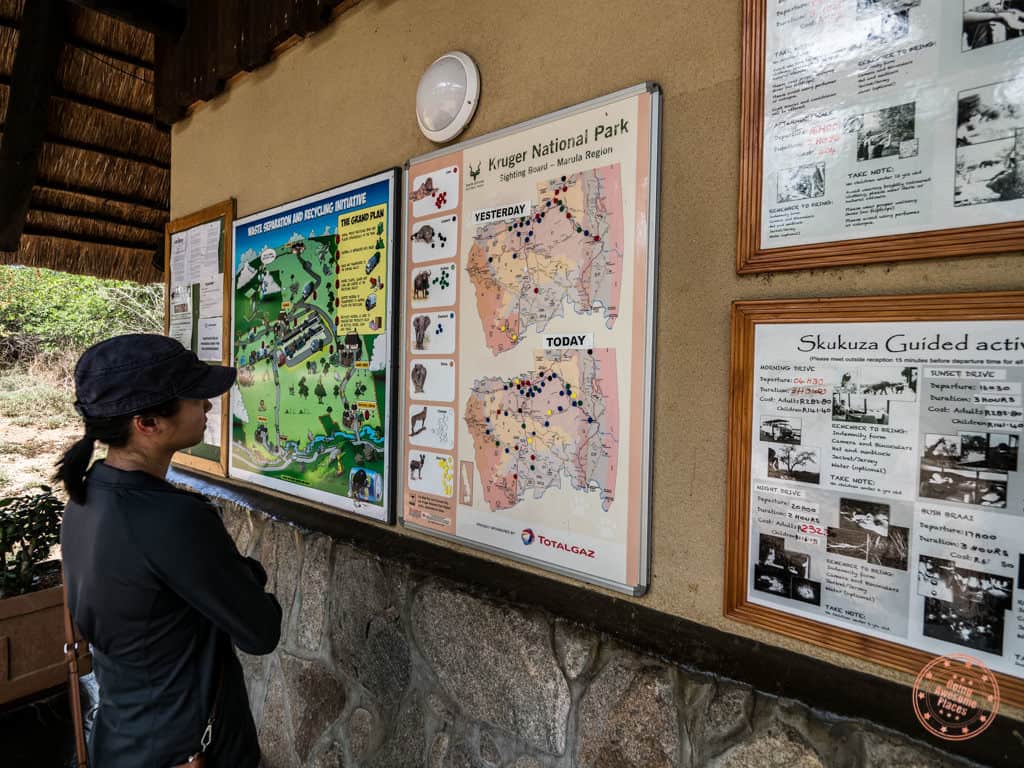
Once you enter the camp, you’ll find all the administrative offices to the left that reminded me of a city hall. It’s in these collection of buildings where you check-in, make bookings and also where you’ll find the post office and bank. Conveniently located at the entrance is also the gas station.
Drive further and you’ll find a large parking lot to gain access to the main cluster of facilities that include the shop, restaurants, and cafeteria.
From there Skukuza extends to the left and right with additional facilities such as the auditorium/conference centre and all of the accommodations and campsites.
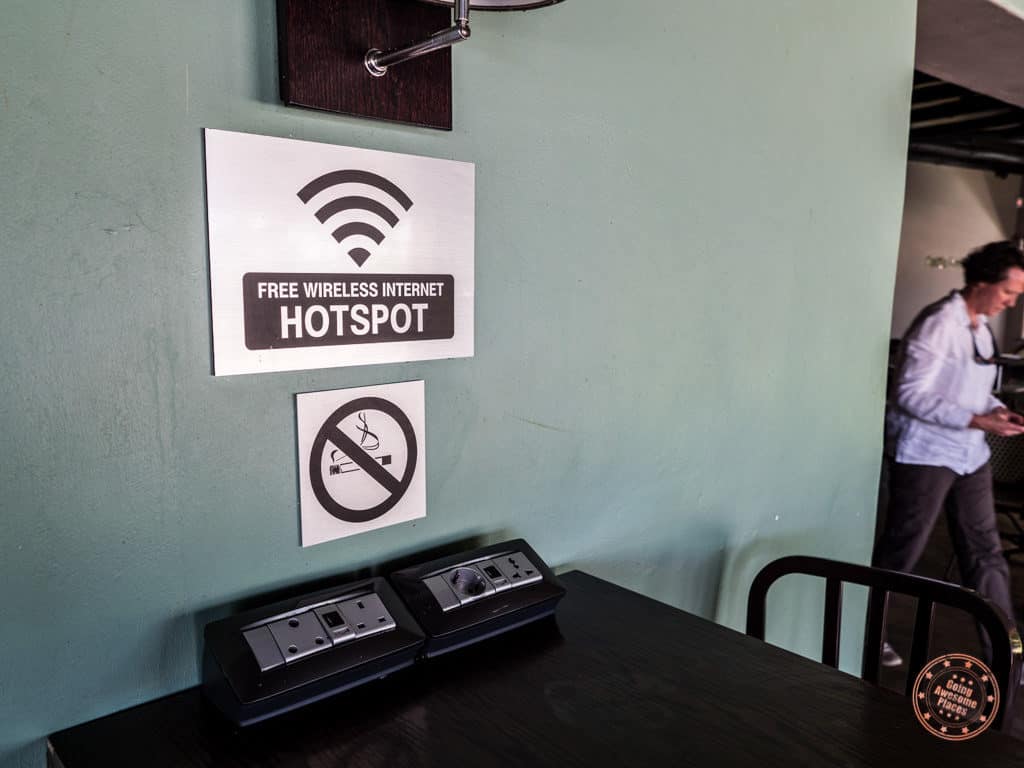
This is the one of the few camps that have free wifi. It’s located at the back of Cattle Baron towards the river where you’ll find a mini internet cafe and lounge chairs.
A nice feature to the the rest camp is that you have an unfenced view of the river. You’re freely able to walk along the pathway that runs left to right of camp. It’s a great place to grab a seat on one of the many benches to read a book and catch wildlife passing through on the other side.
Shops
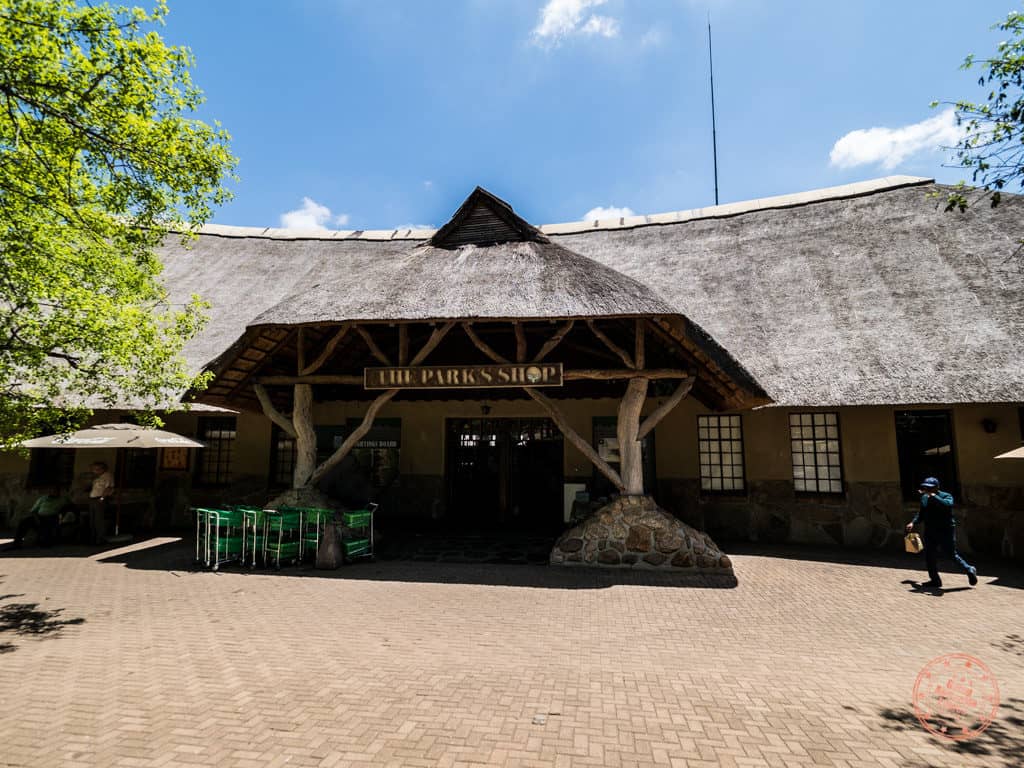

The gift shop is the largest and most thorough of the two rest camps we visited. Not only does the shop have all the customary souvenirs, you’ll also find a mini supermarket here for those looking for on-the-go-food or supplies for cooking. There’s a small pharmacy of basic meds if you’re looking for that. Lastly, all the camping supplies you might need can also be found here so you’re covered if you’ve forgotten anything.
Travel Tips – You can purchase Vodacom top up vouchers at the gift shop. Just ask the cashier and they’ll be able to print them for you.
Restaurants


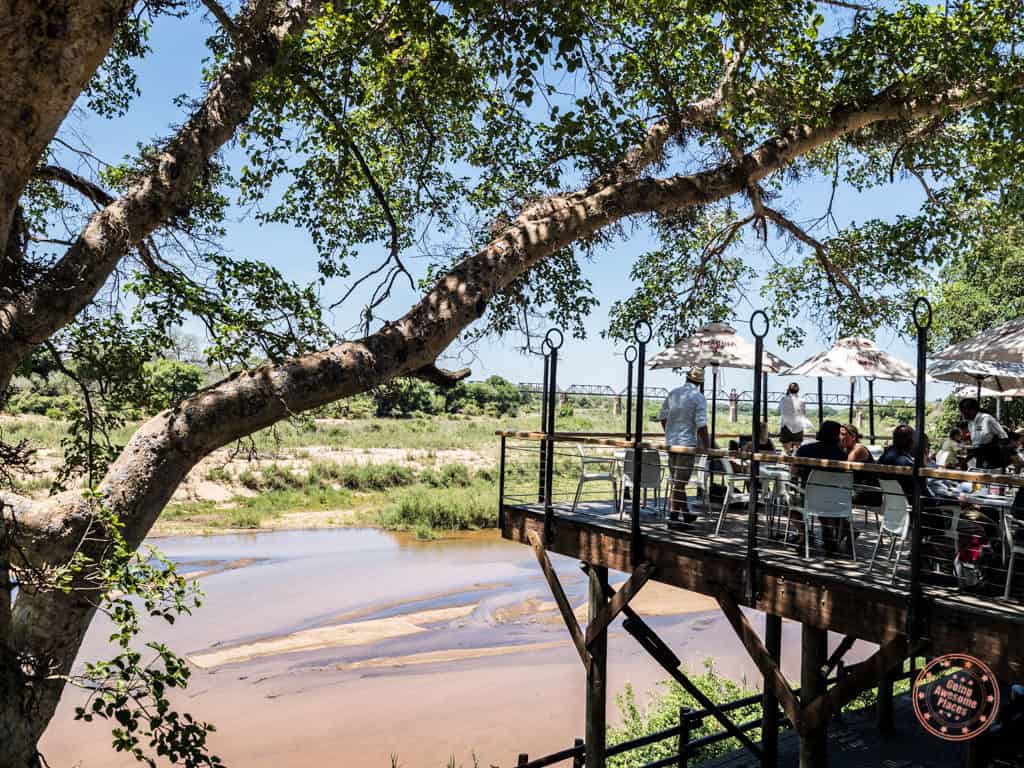
A big bonus for Skukuza is the fact that they have so many food options.
The main restaurant is Cattle Baron. Think of this as a proper sit-down restaurant serving dishes like steak, fish, and pasta. This is also the restaurant that has the buffet breakfast every morning.
Also run by the restaurant is more of a cafeteria-style restaurant where you get in line to order fast-food items such as sandwiches and salads. You wait by the restaurant and when it’s ready they’ll call your number.
By the river is a platform above the river that’s an extension of Cattle Baron but mainly for casual drinks and meals as well.
Activities
Skukuza is unique in that it has its own 9-hole golf course. You can also book a number of activities that are run every day including:
- Morning/afternoon bush walks
- Sunrise or sunset safari drives
- Night drive
Accommodation types
In Skukuza you’ll find camp sites, 21 furnished safari tents, bungalows, cottages and 4 guesthouses.
Facilities
Here are the notable facilities at Skukuza rest camp:
- Post Office
- Public Telephone
- Bank
- Car Rentals
- Gas Station
- Car Wash
- Restaurants + Cafeteria
- Auditorium and Conference Facilities
- Internet Café
- Communal bathrooms/showers
- 2 swimming pools in camp (for overnight residents only)
- Shop (gifts, groceries, camping supplies)
- Laundromat
- Communal Kitchens
- Basic First Aid Assistance
- Cellphone reception
LR2W Riverside Bungalow
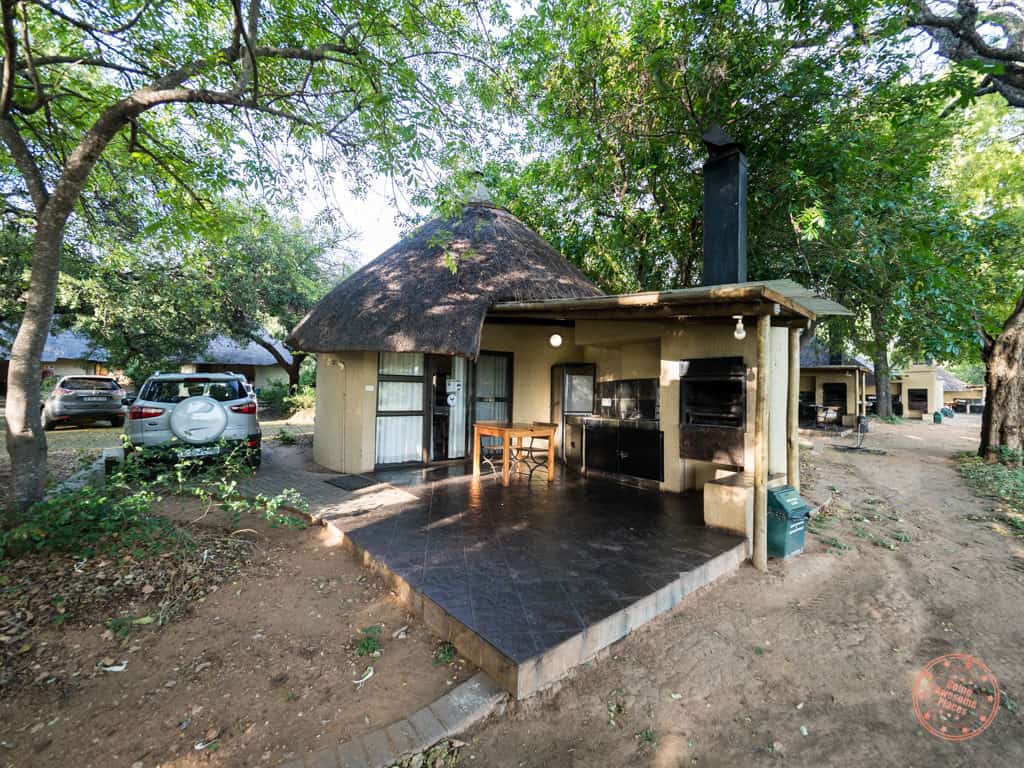


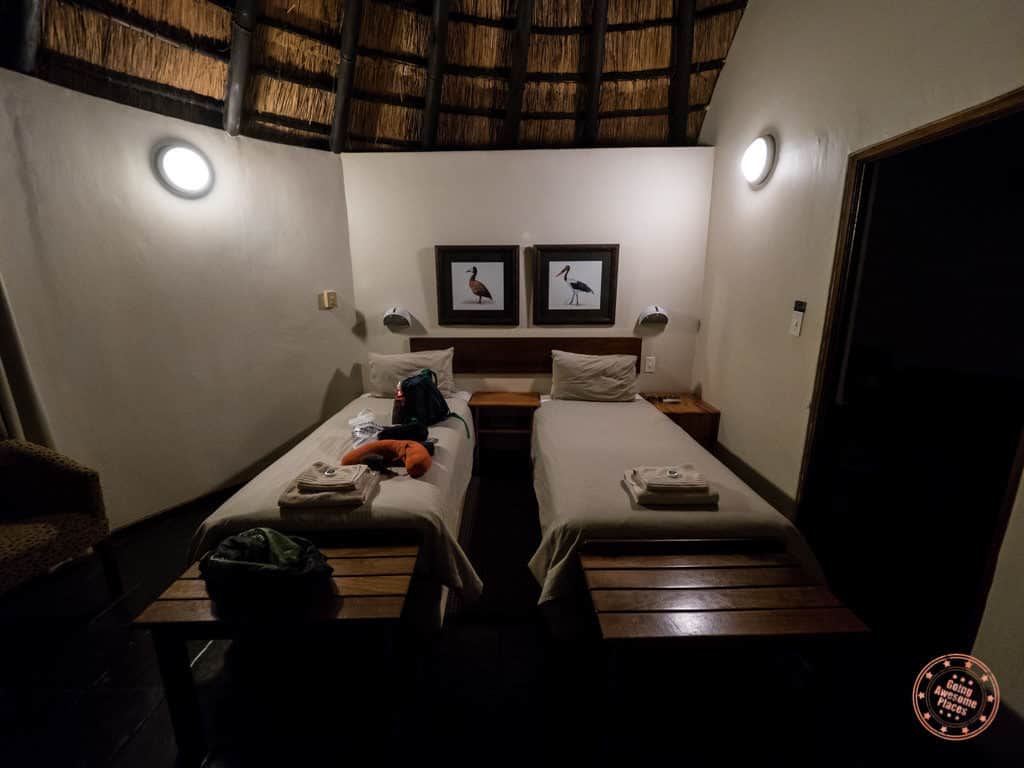
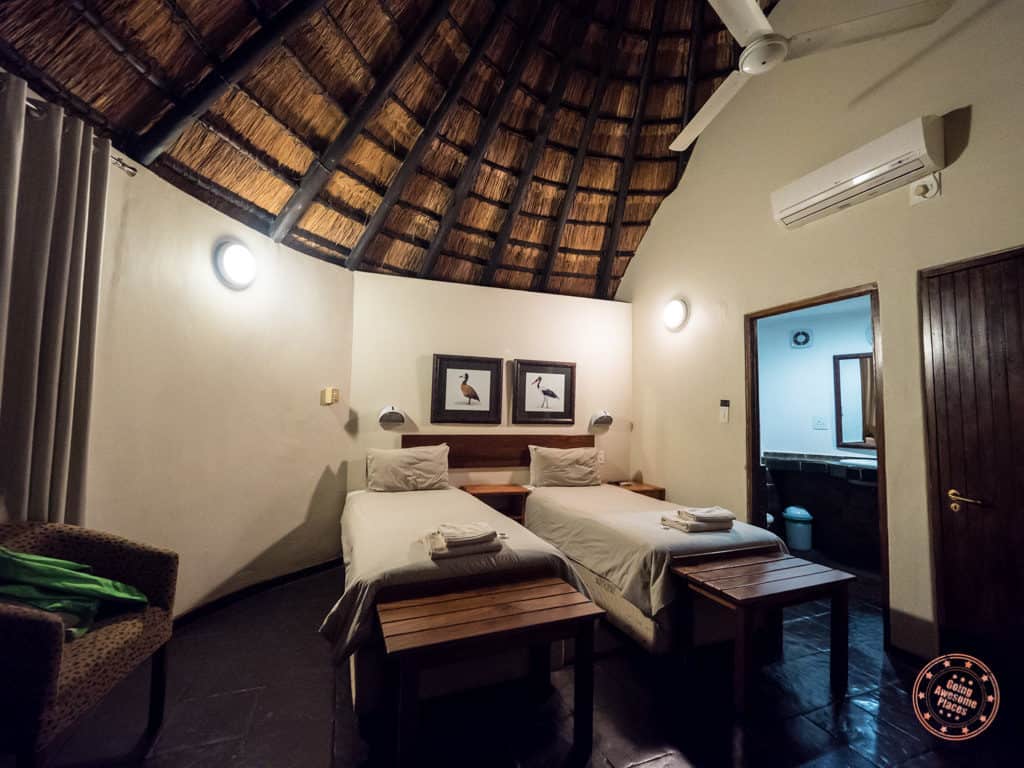
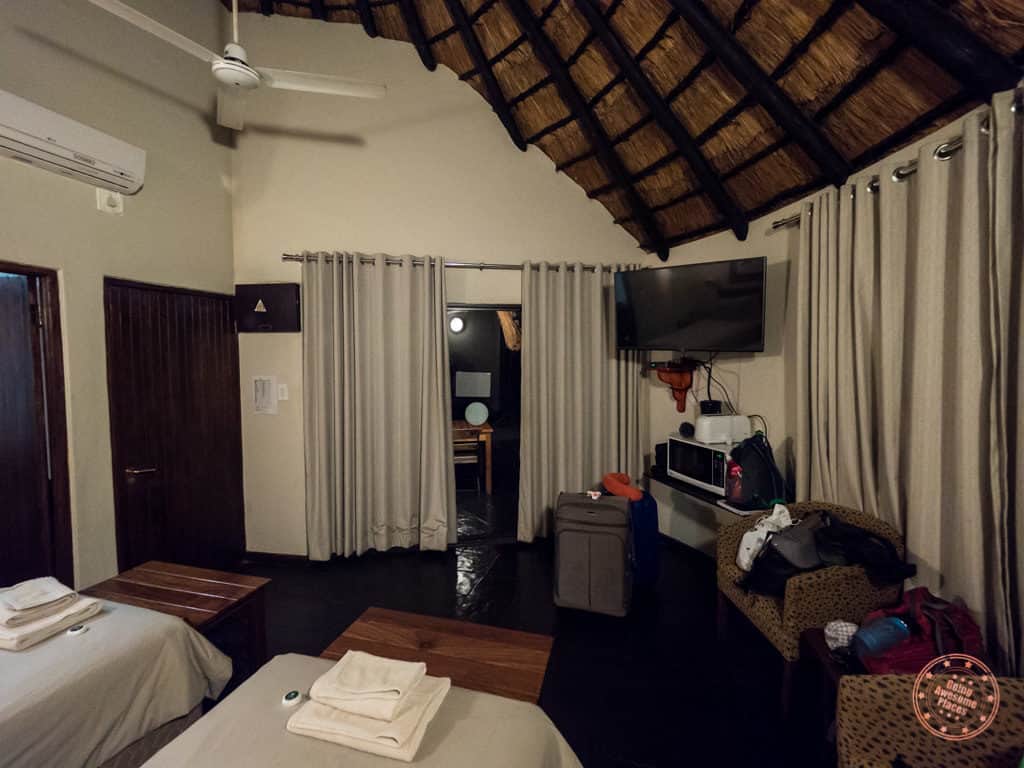
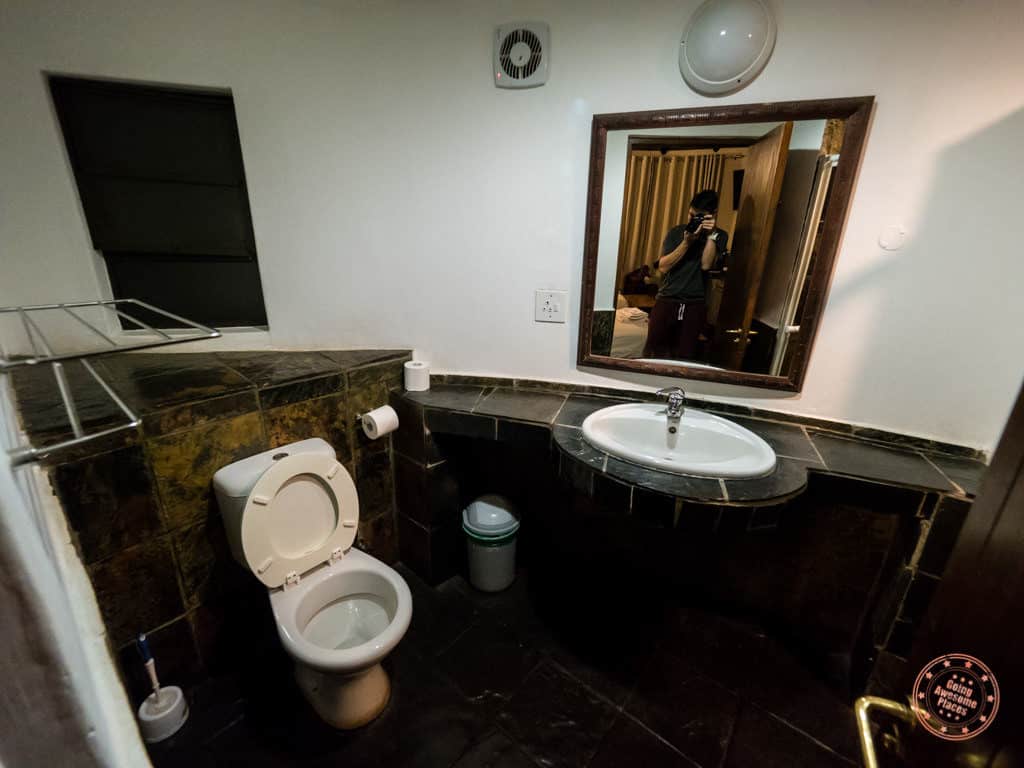
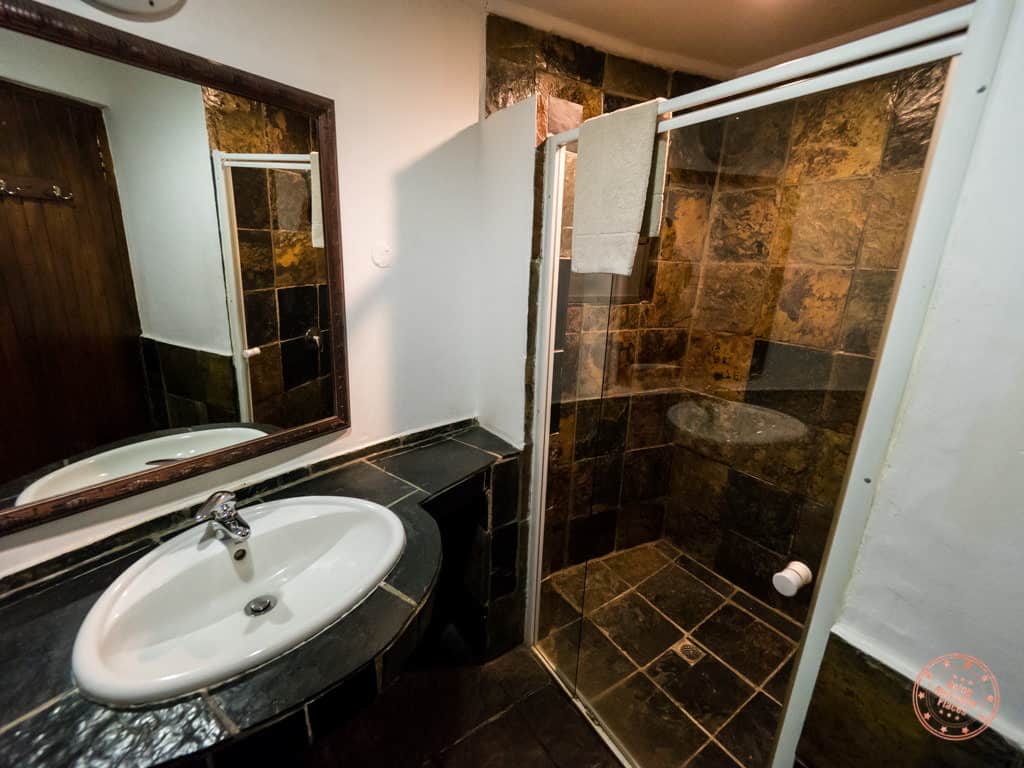
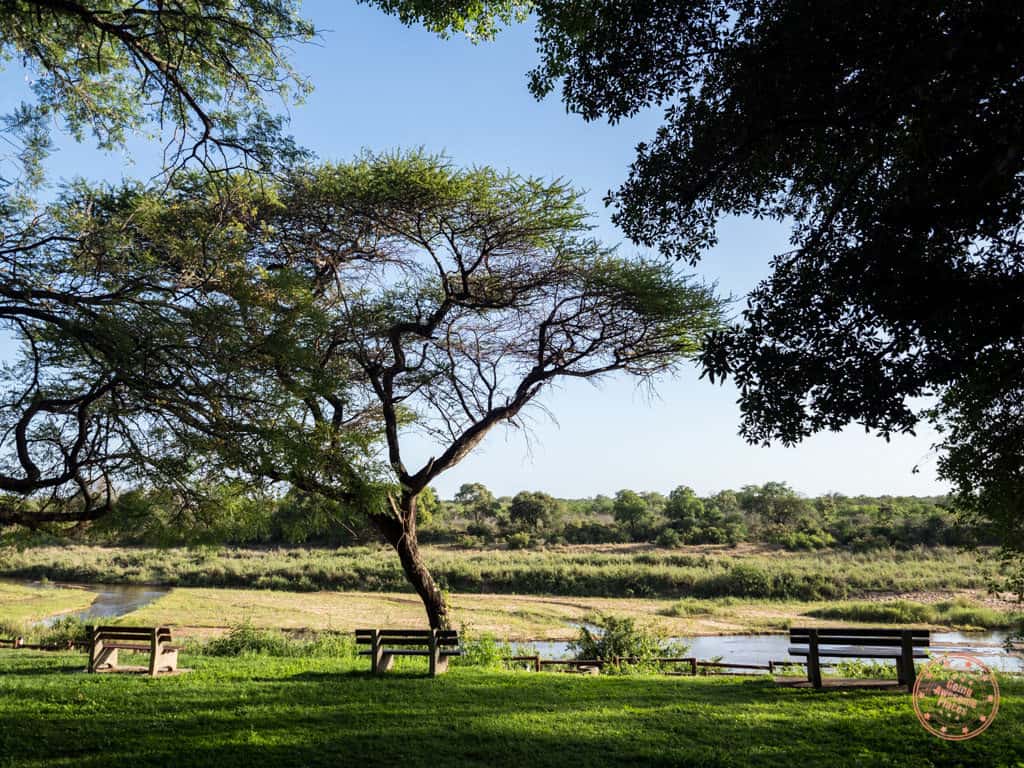
There are quite a number of variations of bungalows, each with their own designation code in the booking system. The particular one that we had was the LR2W Riverside Bungalow and it really is just the standard bungalow except it faces the Sabie River so there’s a small increase in nightly rate.
The Skukuza bungalows are in the rondavel style which means they are circular huts outfitted with an outdoor kitchen, two single beds and private bathroom. Without going for the larger cottages and guest houses that are meant to house more people, the bungalows are your best balance for price, comfort, and size.
Each bungalow has a parking spot next to it so you’re guaranteed a place for your car.
The bungalows themselves do show some age so don’t expect them to blow your expectations in any way. There isn’t an incredible amount of space but for two people it’s just enough and seeing as you’ll only be in the bungalow to nap or sleep, you really don’t need too much.
Inside the bungalow you’ll also also find air condition and an old school TV hanging on the wall but it’s unlikely that you’ll be using it.
The outdoor kitchen is unique in that there’s a full-sized fridge, stove, and pots and pans but all the cabinets are locked up and the fridge has its own metal cage around it. For those staying in Kruger a long time, it makes sense to use the kitchen but for anyone focusing on safari in Kruger for a few days, you’ll likely won’t get too much use out of the kitchen.
I would equate the bungalows at Skukuza to a small motel so go in with that expectation in mind. The rondavel style architecture is unique to the locale and has everything you need for a comfortable night’s sleep.
Review of Lower Sabie
Lower Sabie is really a miniature version of Skukuza with a great vantage point over the Sabie River and high chance of animal sightings.
Key Features
- Wheelchair accessible
- Drives in a lot of animals throughout the year
- Family oriented camp
- Attracts many varieties of bird species
Grounds
From the parking lot, there’s essentially a long walkway that takes you down to the restaurant and viewing platform above the banks of the Sabie River. Along the way is the main reception building for check-in, post box, and gift shop.
Near the entrance is also a gas station.
One thing you’ll notice that stands out with Lower Sabie are the large green spaces that is set up amongst the accommodations and the main facilities. These green lawns also feature giant sycamore fig trees which is why it attracts so many birds. You also get a nice view of the river including the other side but there is a fence in place which obstructs your view so in that way, the boardwalk of the rest camp is not as nice as Skukuza.
Shops
The gift shop at Lower Sabie is a fraction of the size what is at Skukuza so as you’d expect there’s slightly less selection.
Restaurants
The restaurant/cafeteria/cafe is operated by Mugg & Bean which is a popular chained cafe in South Africa. This is more full-service than most but it gives visitors an option of grabbing a coffee or quick sandwich to go or sit down and have a proper meal.
The food they serve is equivalent to something like a Denny’s or Applebees but the pricing is quite reasonable.
The best part about the restaurant is the viewing deck. It can get windy there at night but during the day, there’s an opportunity to see a ton of action on the river and on the banks of the other side.
On our last day, we saw numerous hippos wading in the water and a male lion passing through as if to say goodbye to us.
Activities
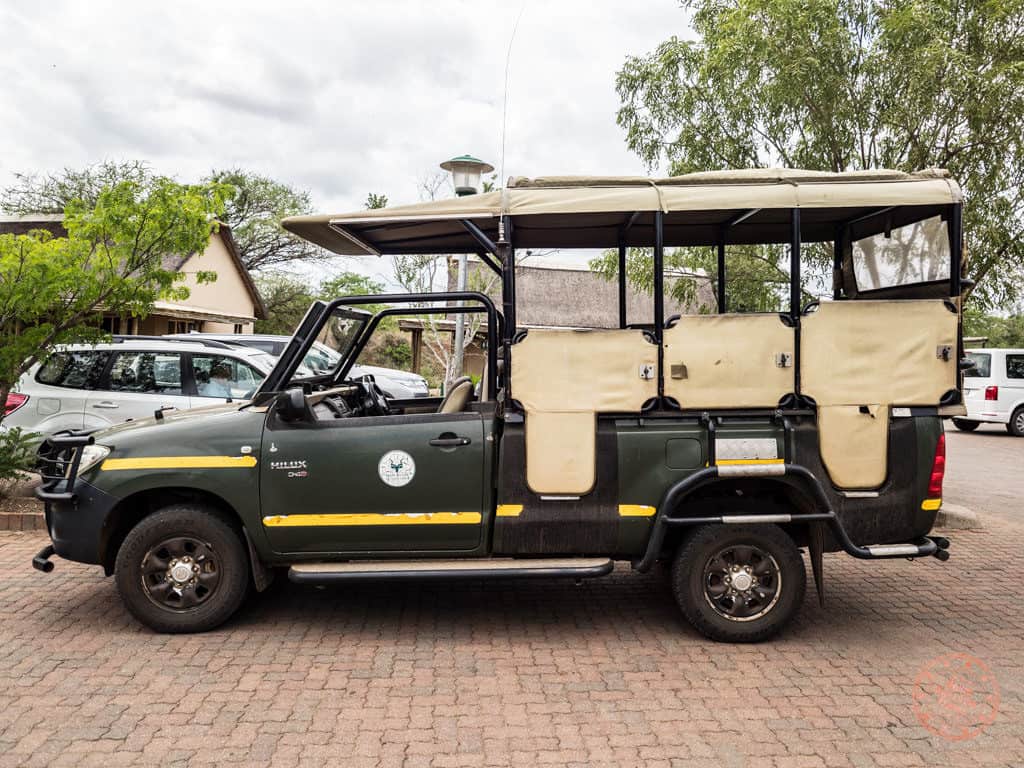
Lower Sabie offers a number of activities but note that typically there is only one truck for each activity type which is different from Skukuza which typically runs 3 trucks per activity.
- Morning/afternoon bush walks
- Sunrise or sunset safari drives
- Night drive
Accommodation types
At Lower Sabie, you’ll find luxurious guesthouses, family cottages, huts, bungalows, safari tents (including semi-luxury 2-bedded tents) and campsites.
Facilities
Here are the notable facilities at Lower Sabie rest camp:
- Public Telephones
- Post Box
- Clinic and Basic First Aid Assistance
- Restaurant/Cafeteria/Cafe
- Swimming Pool
- Gift shop
- Emergency Road Service
- Petrol/ Gas Station
- Laundromat
- Cellphone Reception
- Communal Kitchens & Ablutions
- Limited DSTV only available in Guest Houses
- Separate Day Visitors Picnic Area and swimming pool on perimeter of camp
BD2 Bungalow

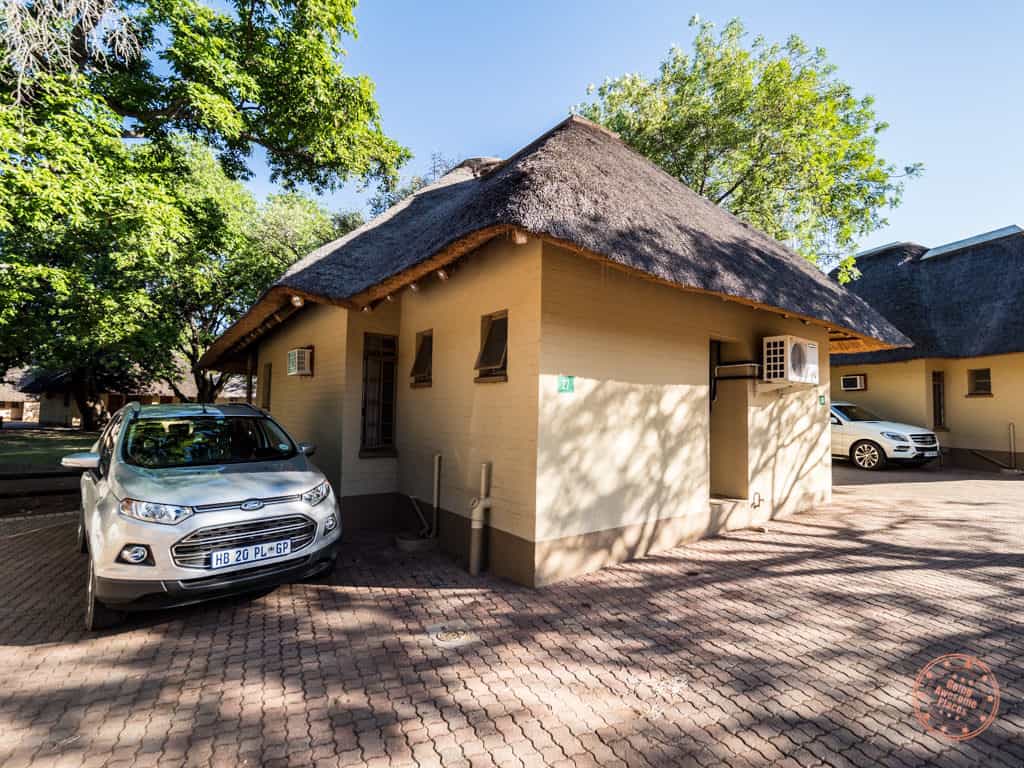

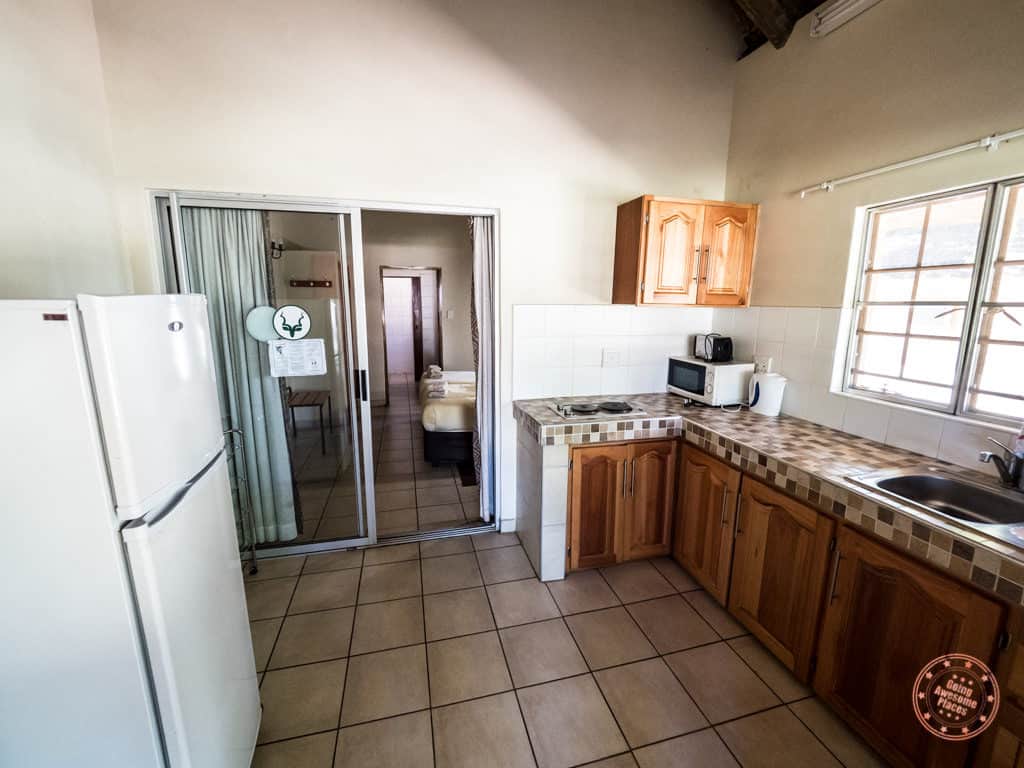
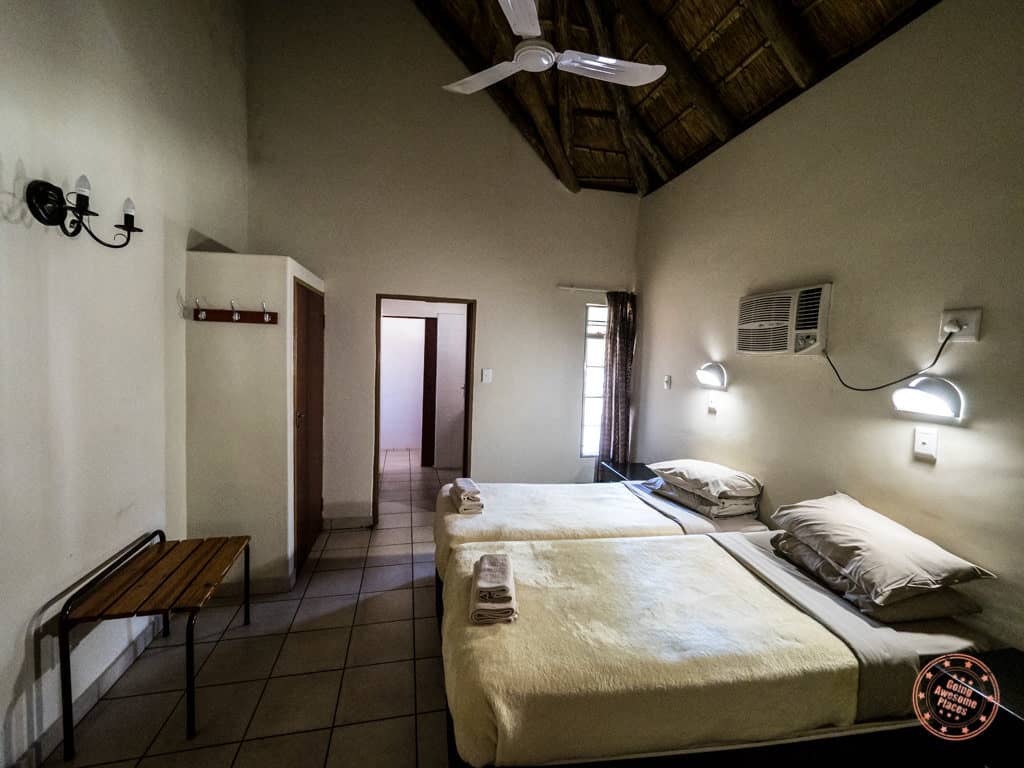
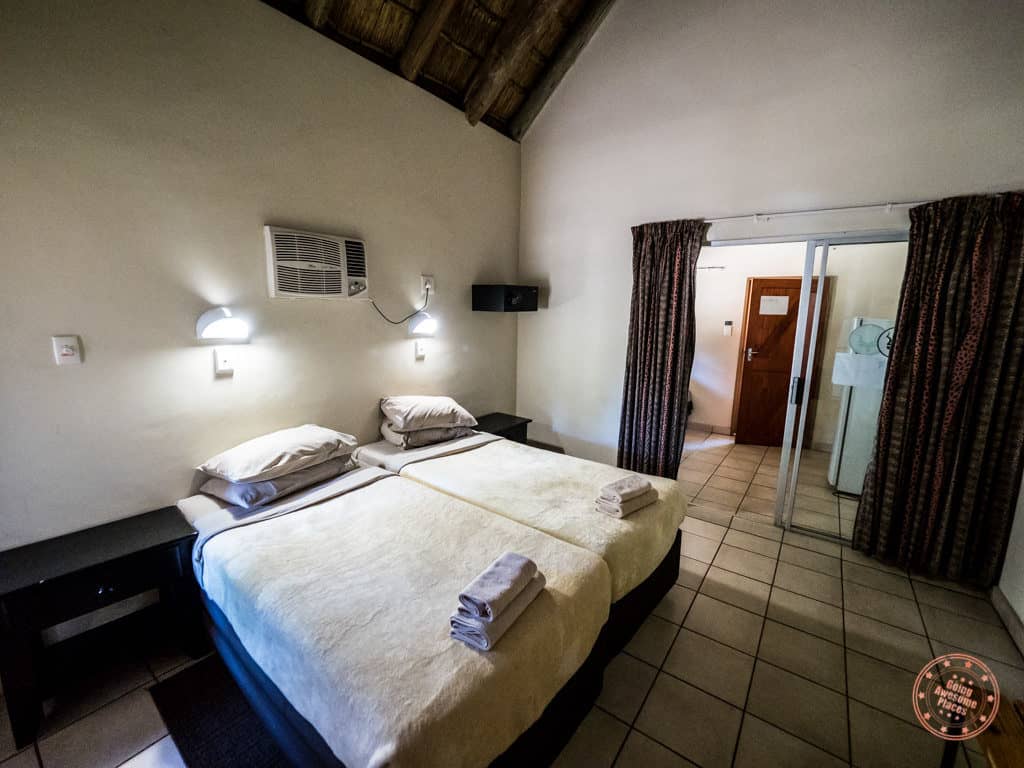
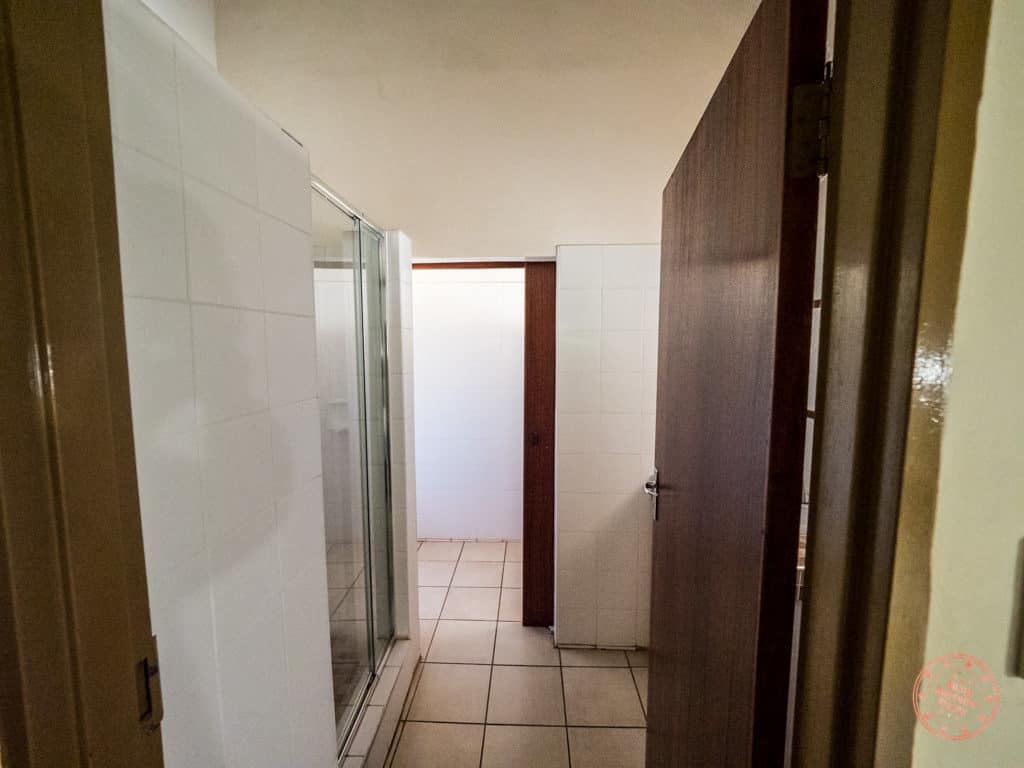
I was looking for an accommodation in a similar class to the LR2W Bungalow at Skukuza and it looked like the Bungalow was the way to go once again.
While the accommodation essentially got us the same type of amenities such as our own private parking spot, kitchen, private bathroom, two single beds, and TV, the architecture and layout of this bungalow was completely different. As if built in a totally different time, this was not in the rondavel style and instead in a more modern cottage floorplan.
You enter in through the front screen door and you’re immediately in the kitchen (yes this one’s actually indoors). You then go through another door and this is the bedroom. Go through another door at the back and you’re in the bathroom with separate subdivided sections for shower, toilet, and sink.
Overall, I’d say the bungalows in Lower Sabie is more spacious and modern. It was definitely a nice bonus that the kitchen was inside as it did feel a little awkward to have to keep going in and out to access things. That’s why we were more comfortable with buying a few Savanah Dry’s at the gift shop to drink in our bungalow.
The bungalows also have their own circular BBQ charcoal grill if you so choose to use.
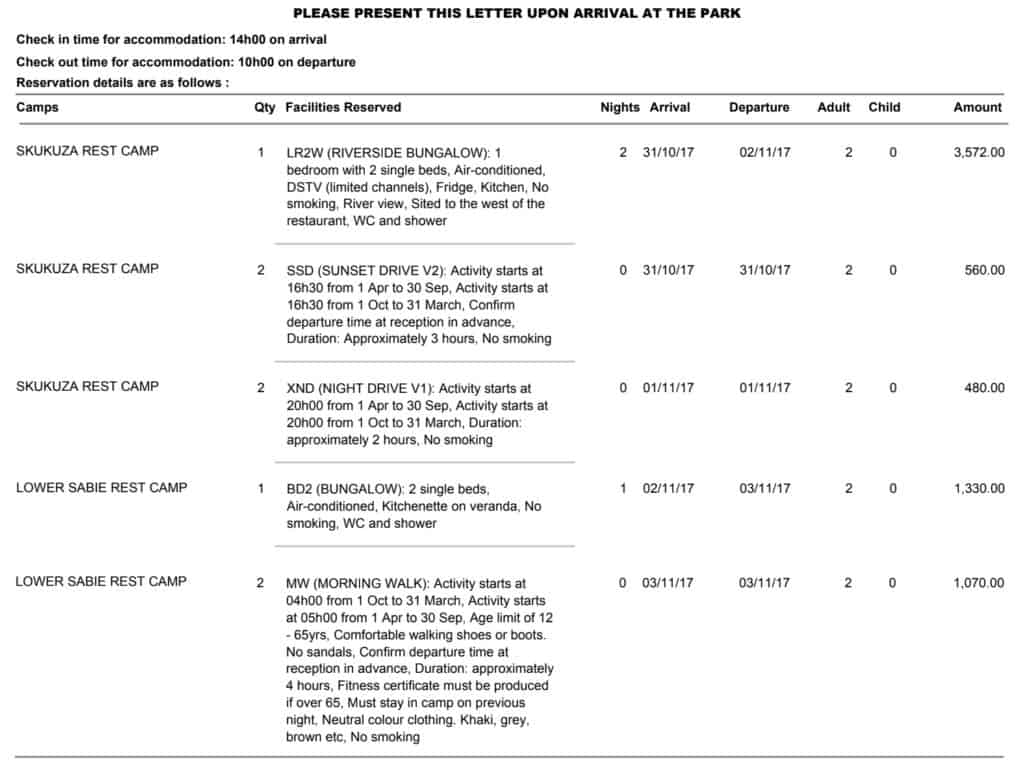
Everything Else
There are few things that I wanted to cover that didn’t make sense in any of the other sections so let’s dive right in.
Check Out Process
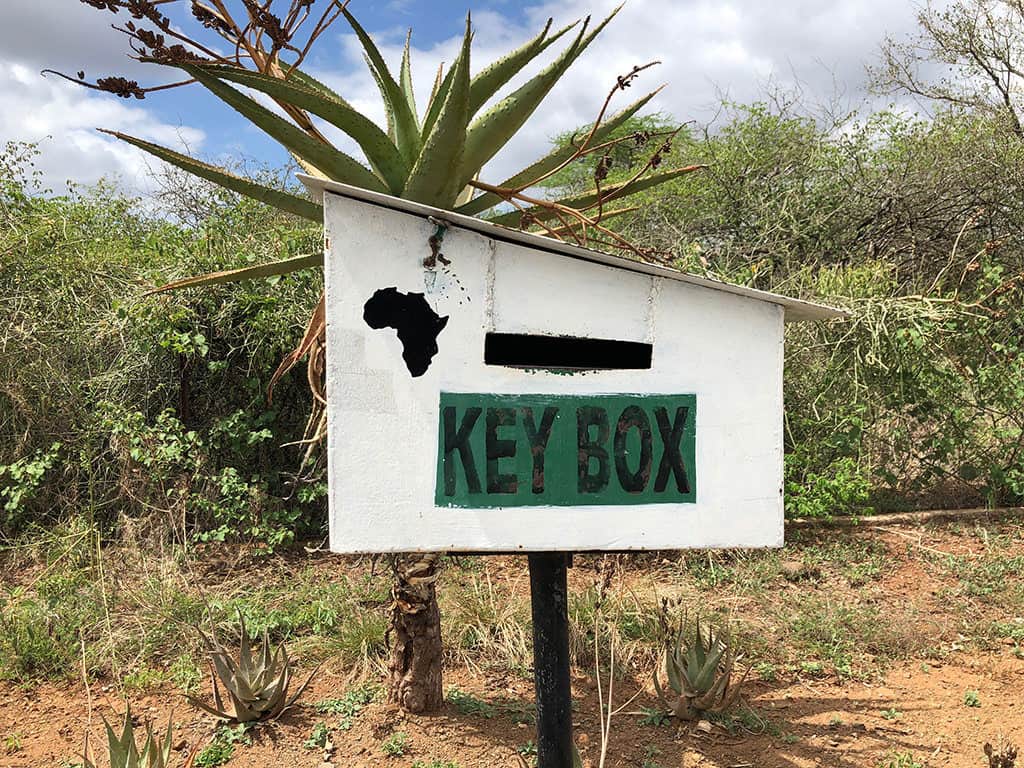
This is super easy. Check out times at all camps is 10AM. When you’re all packed up and good to go, you don’t need to go to the registration office. Simply drop the keys in the box as you exit the gate and that’s it!
Power Outlets
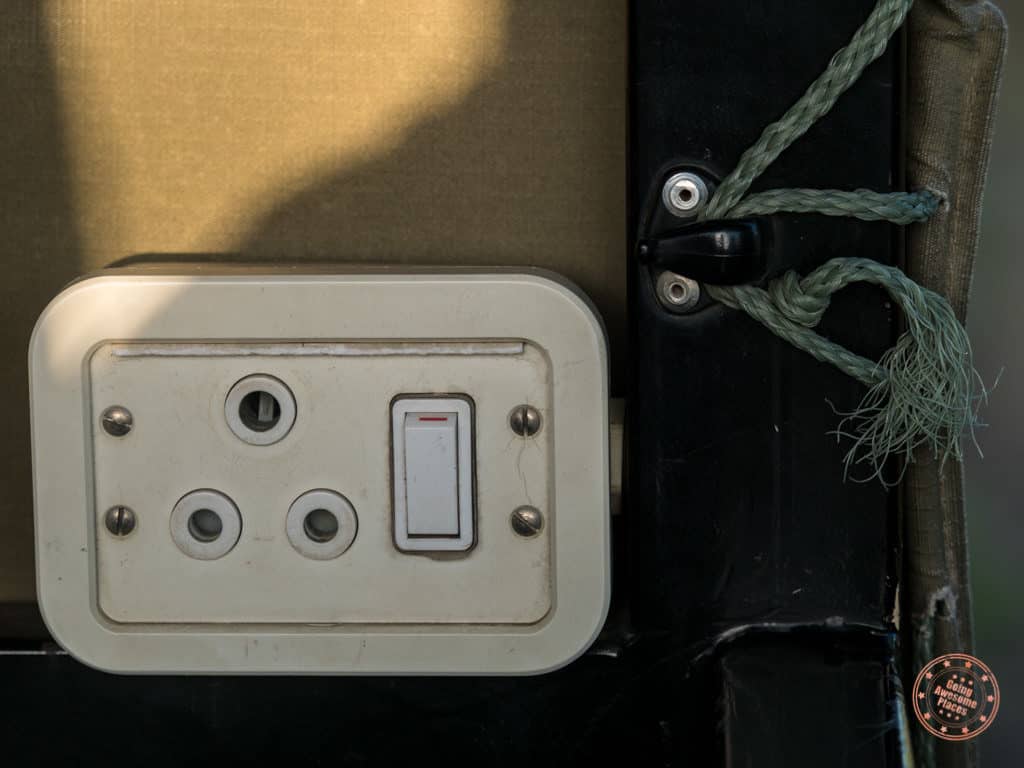
In each of the bungalows that we had, there were just enough outlets to work with to charge our gear either throughout the day or in the evening. Skukuza’s bungalows were a bit smaller and so they actually had a power bar for the TV. I unplugged all the things that were connected to it and used it to plug in all of my devices instead.
You’ll also be surprised to hear that there are some outlets on the large safari trucks at Kruger.
Do you have any questions that I haven’t touched on here? Make sure to drop a comment down below and I’ll make sure to get back to you right away.
What you should read next